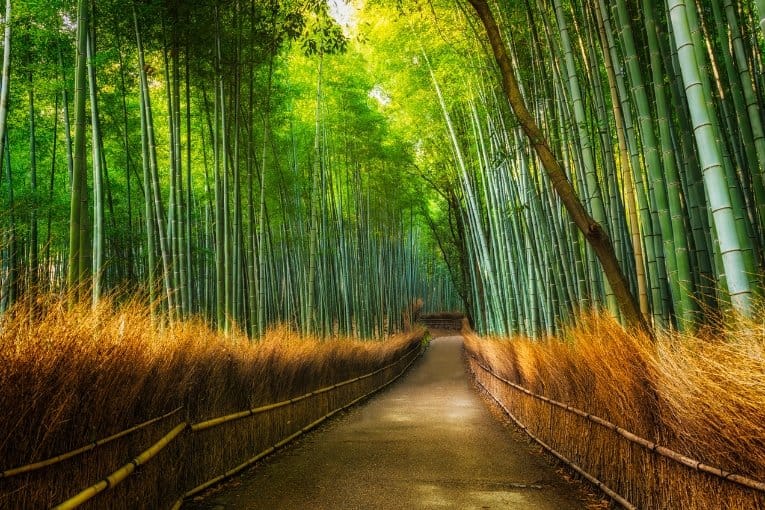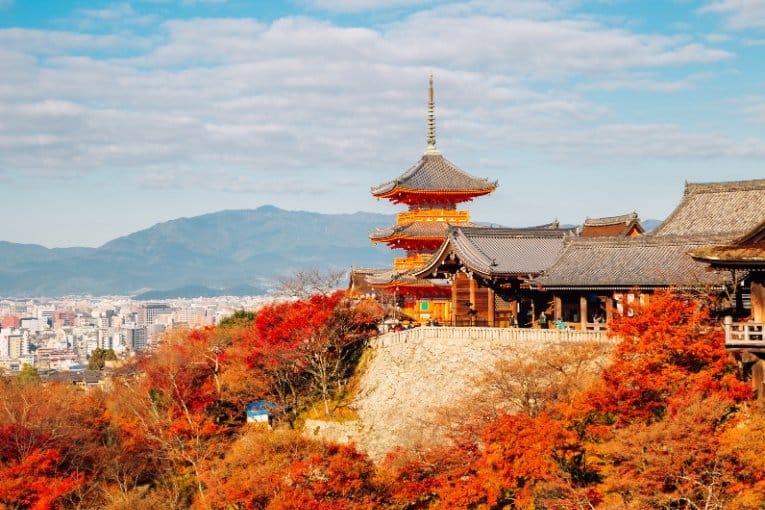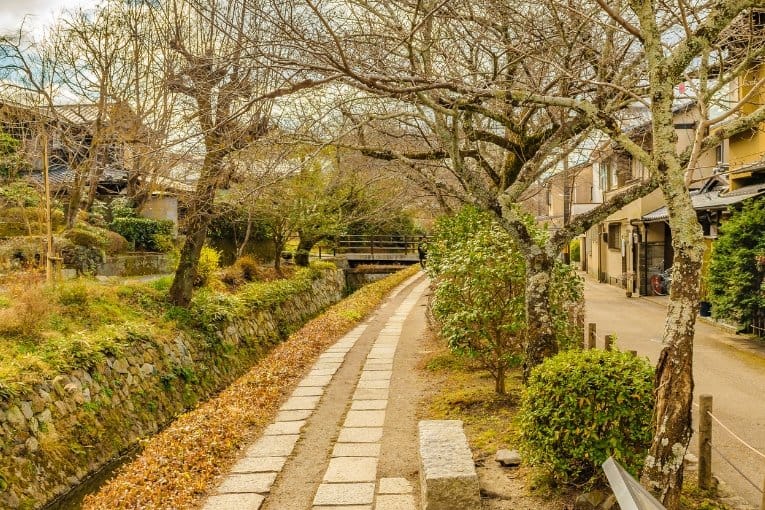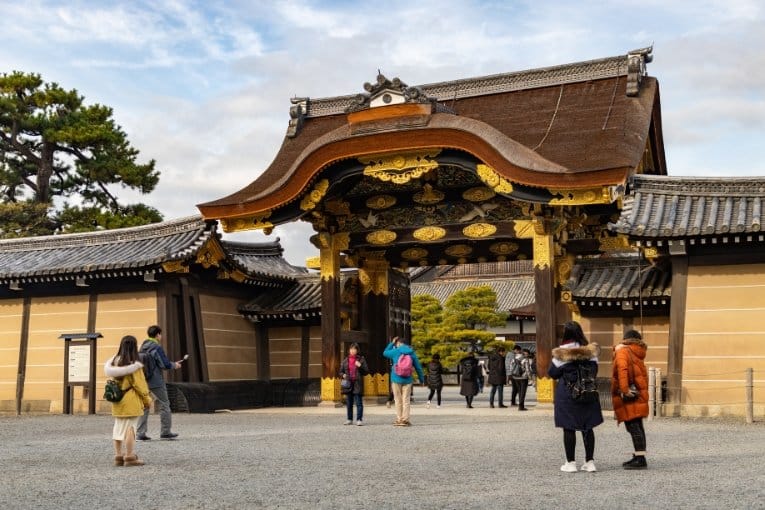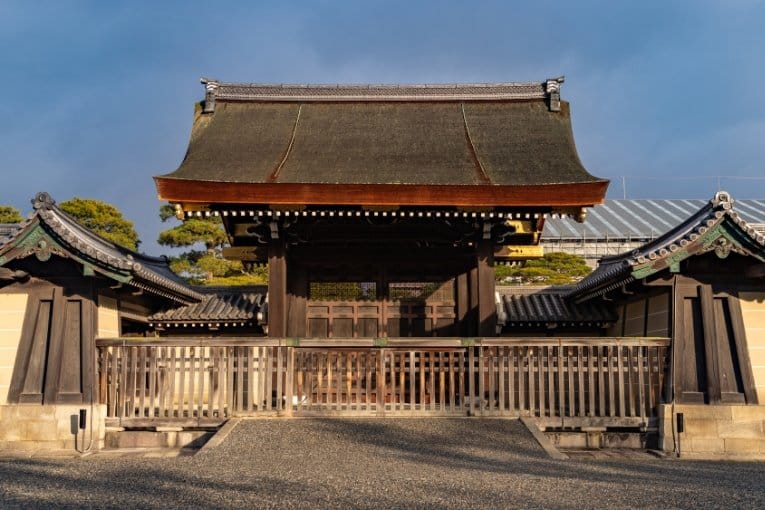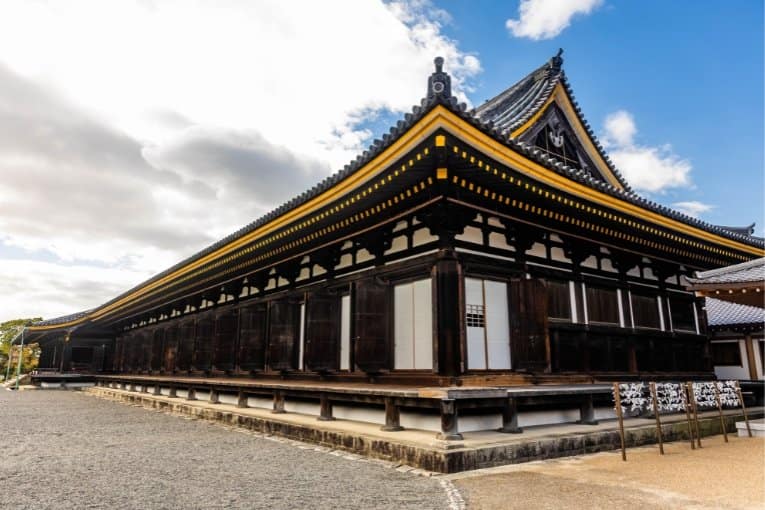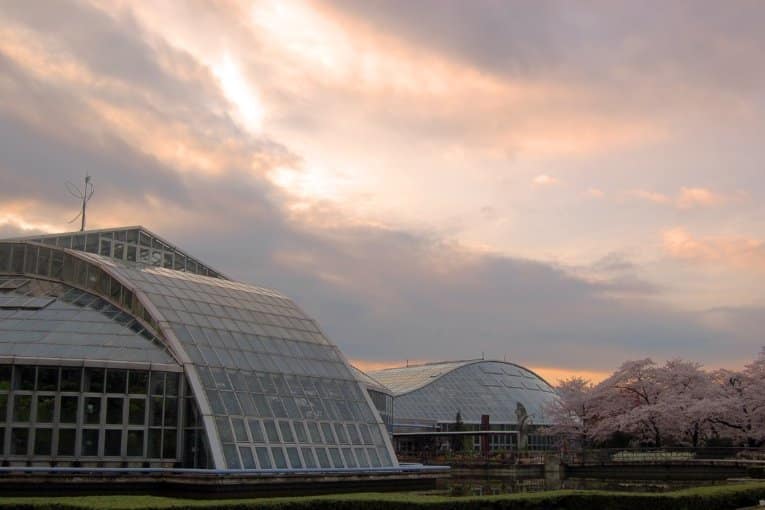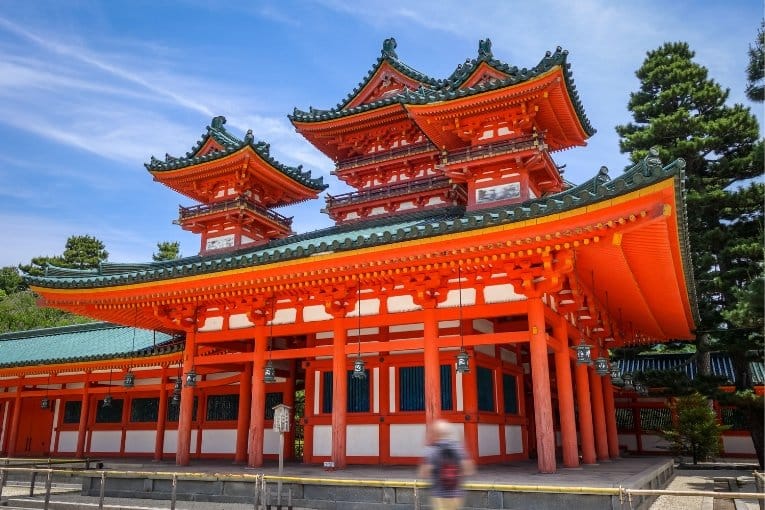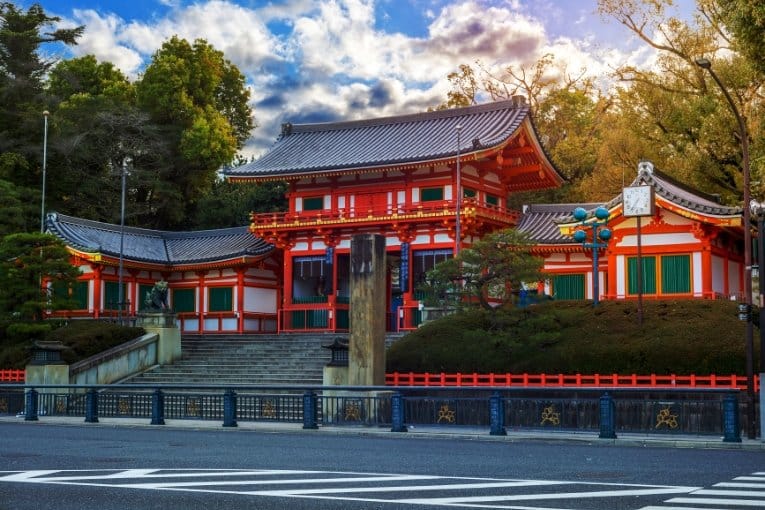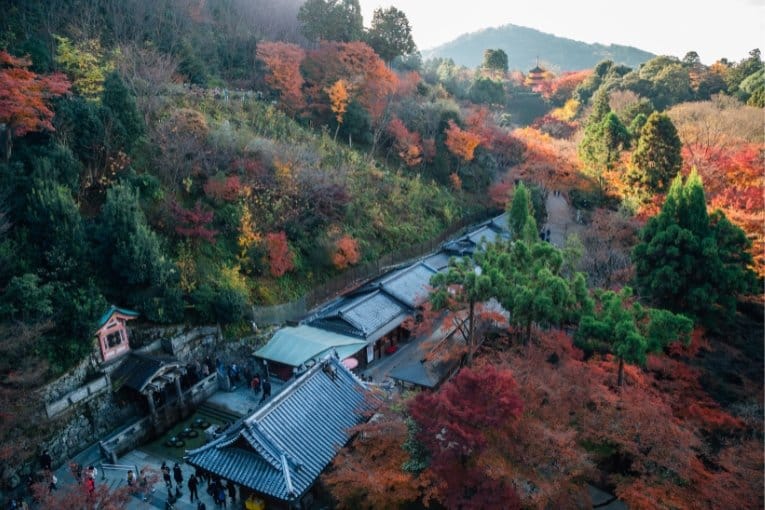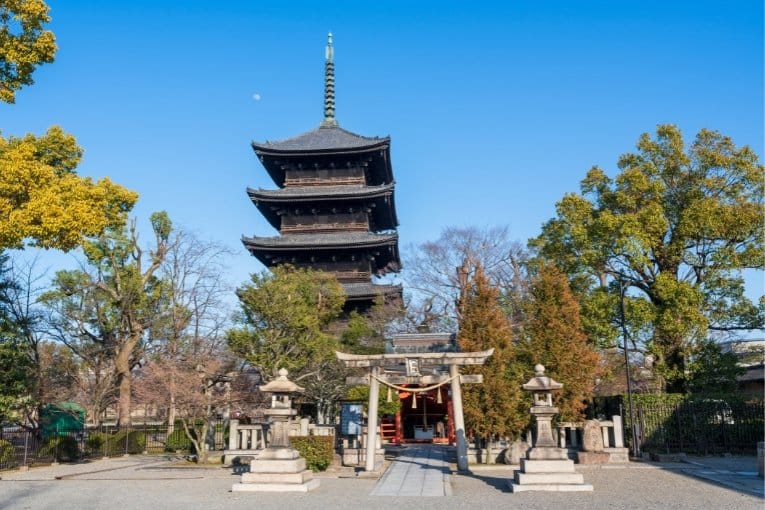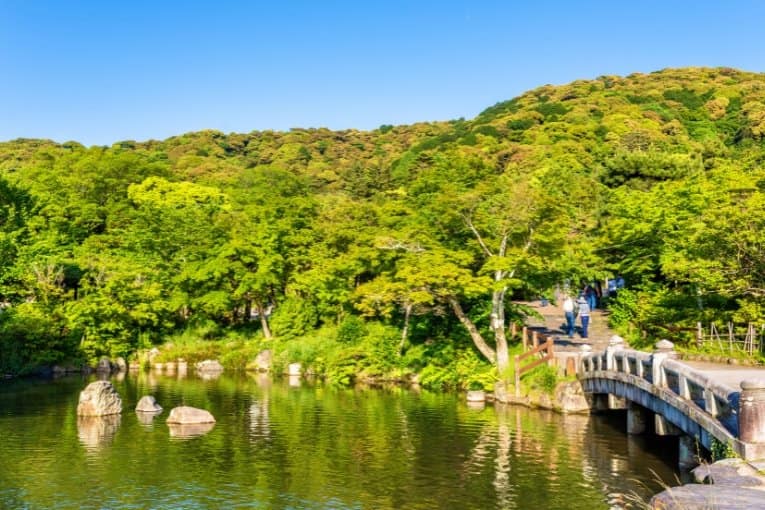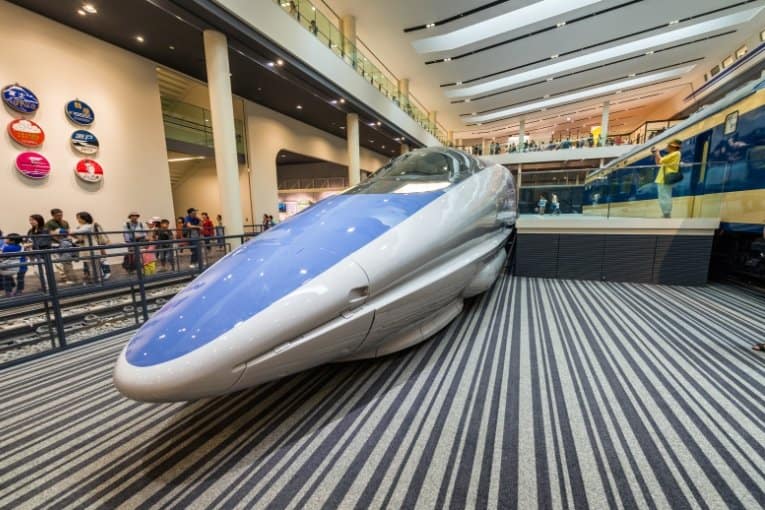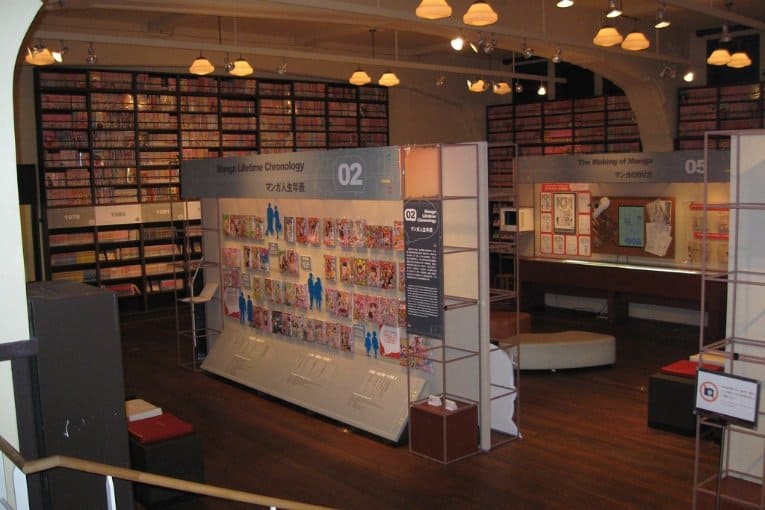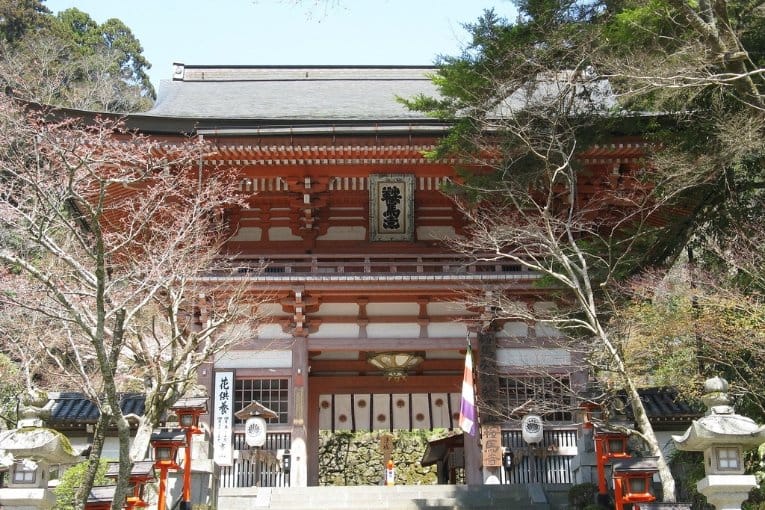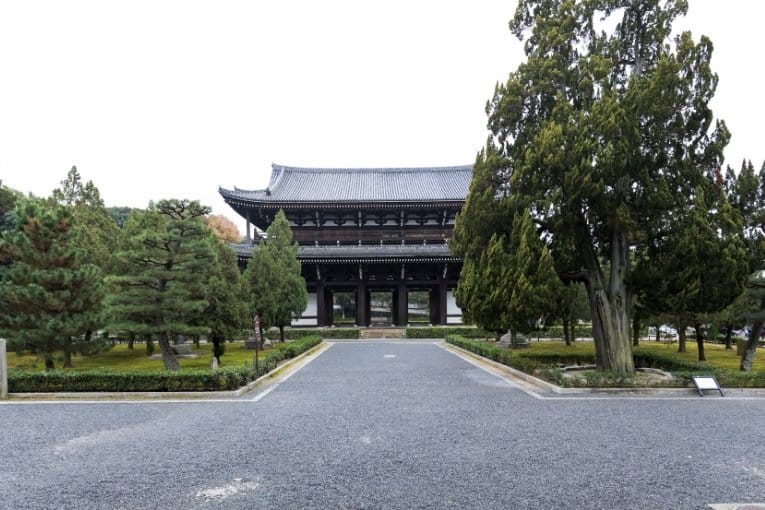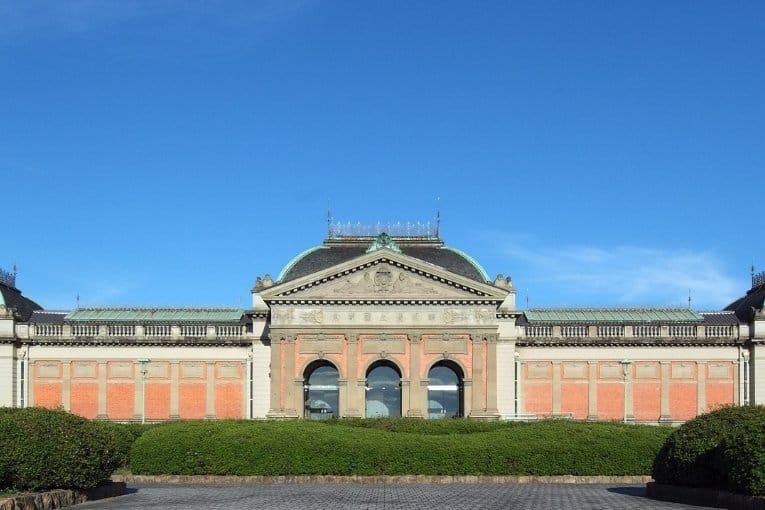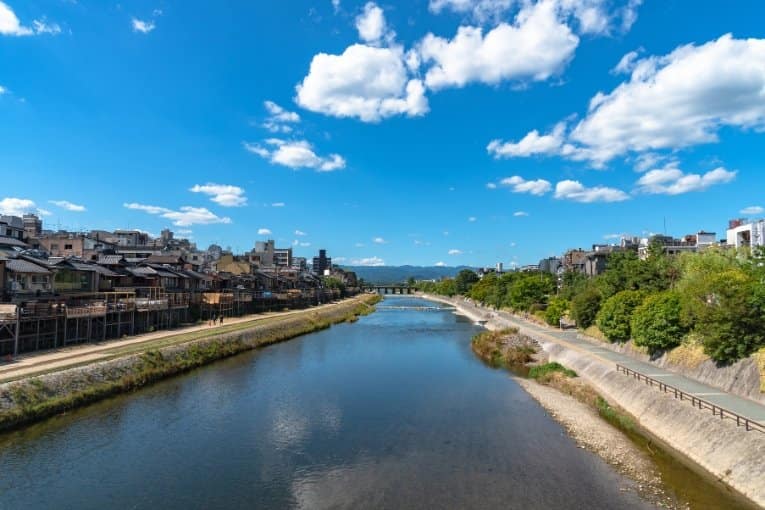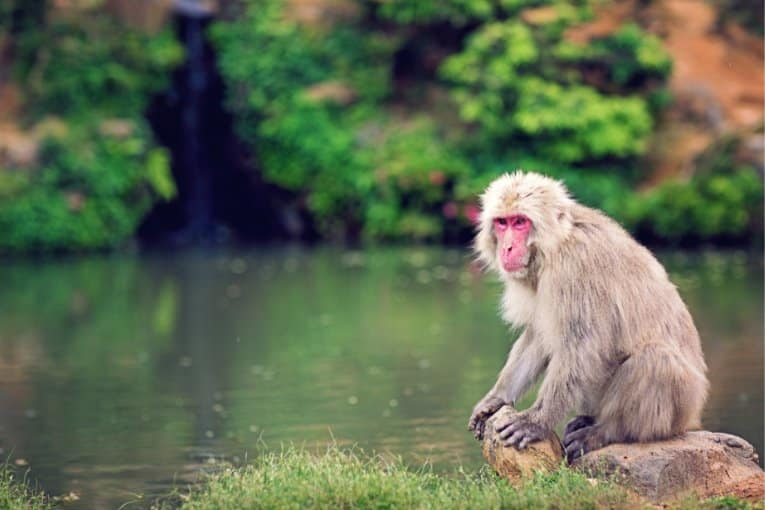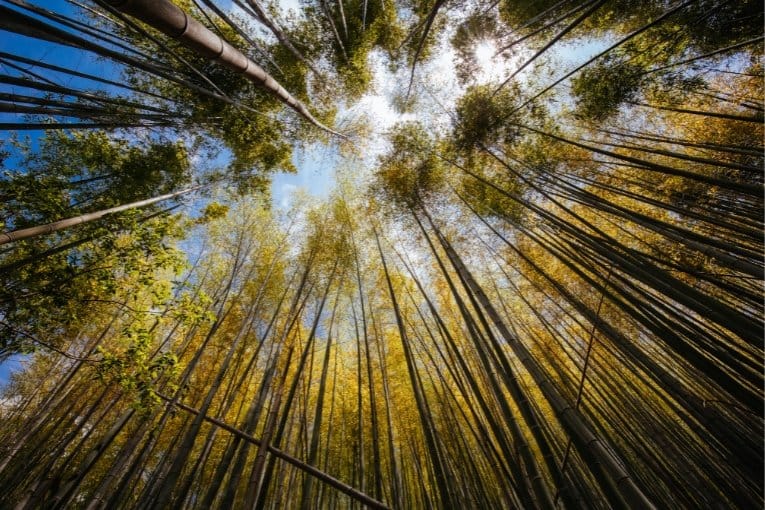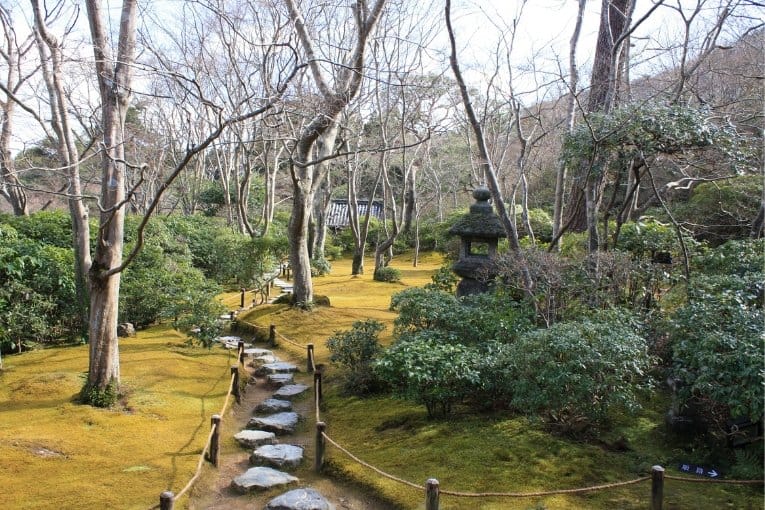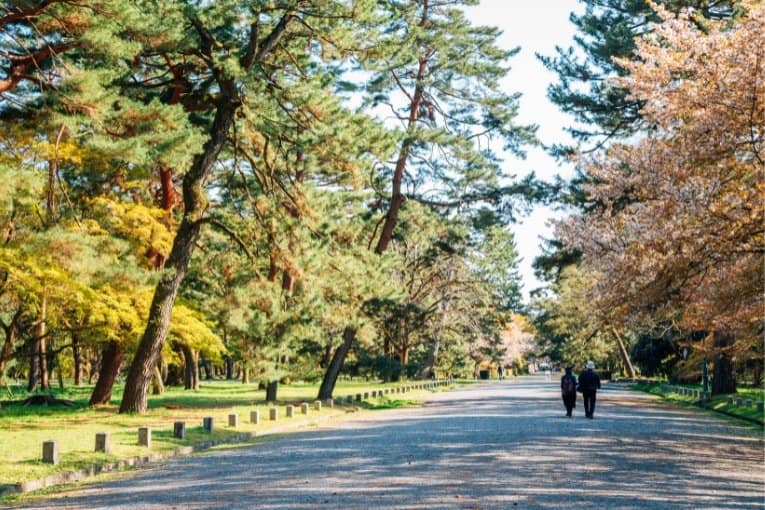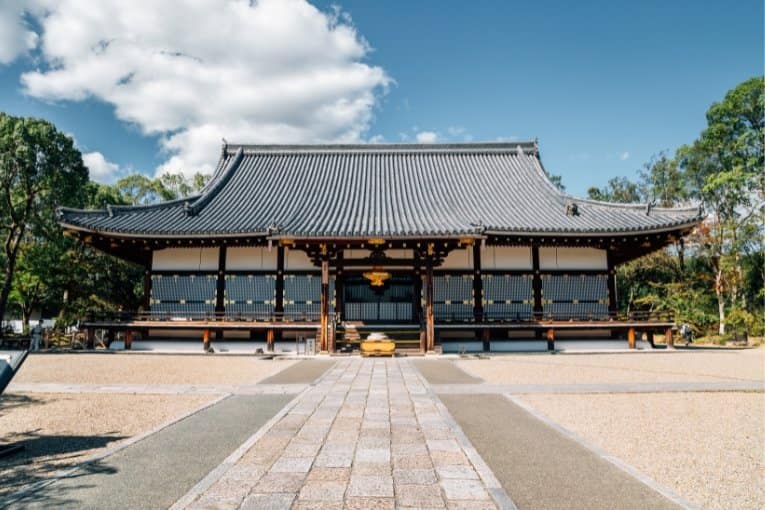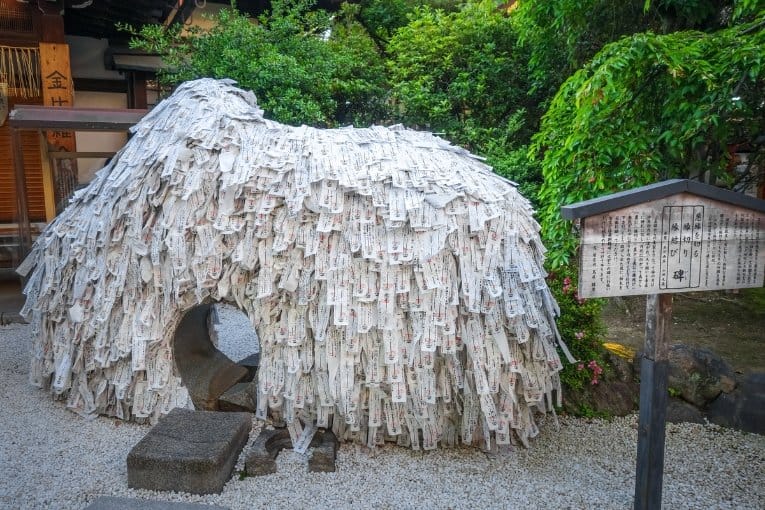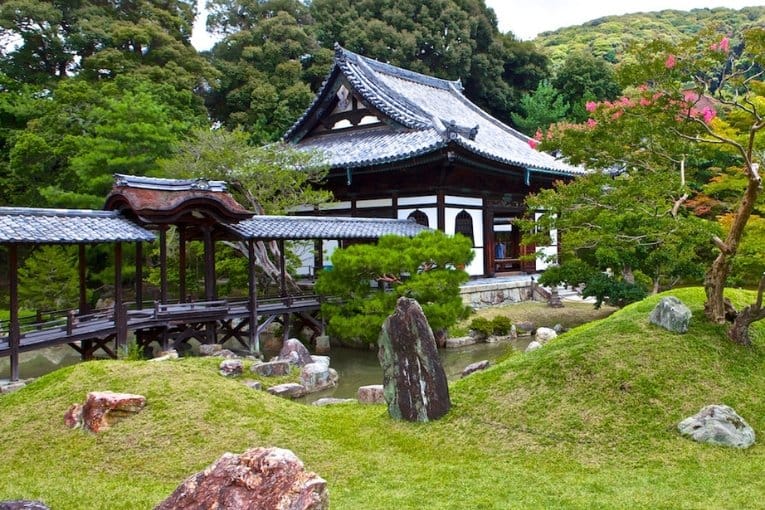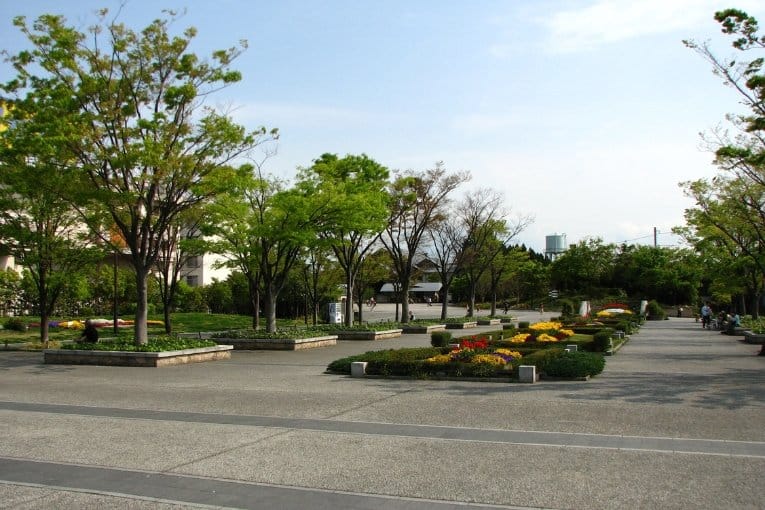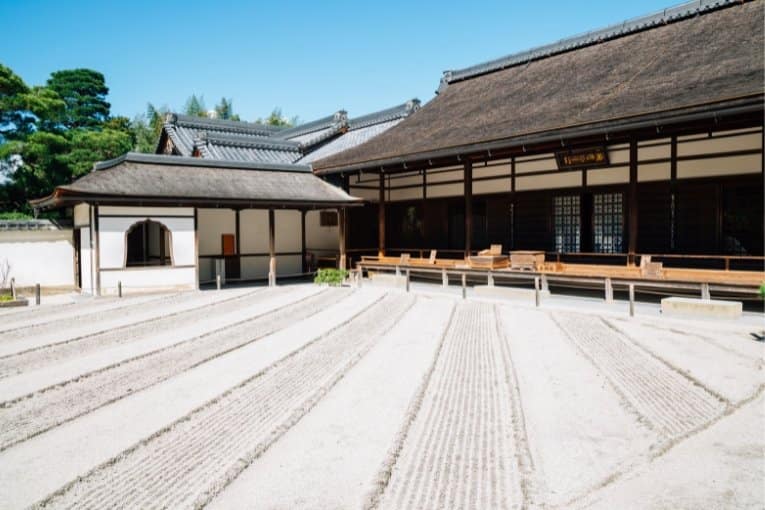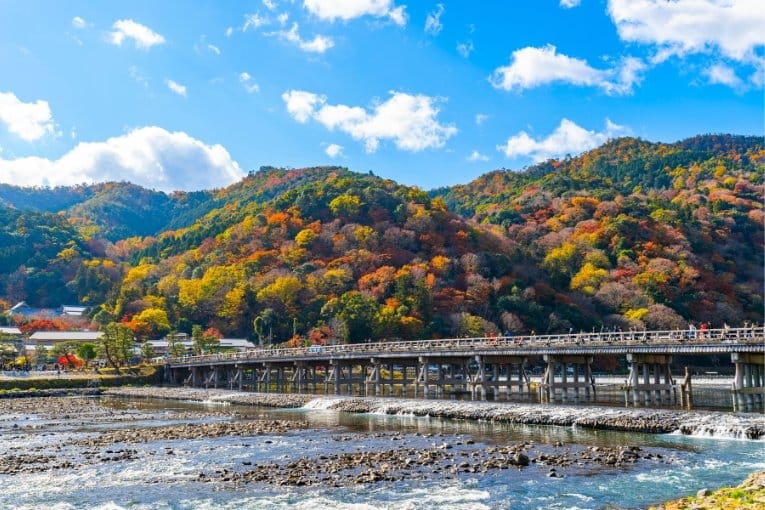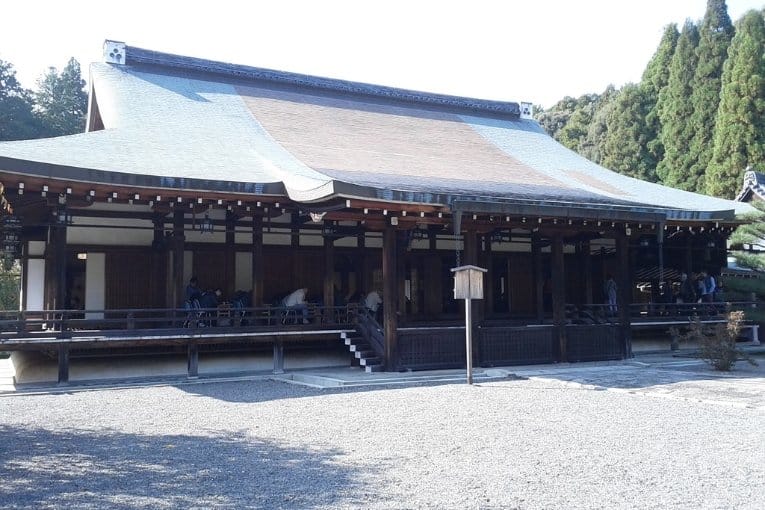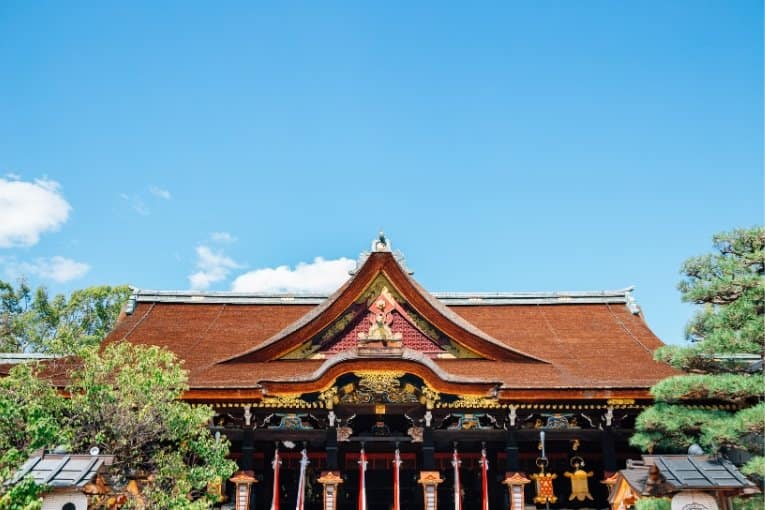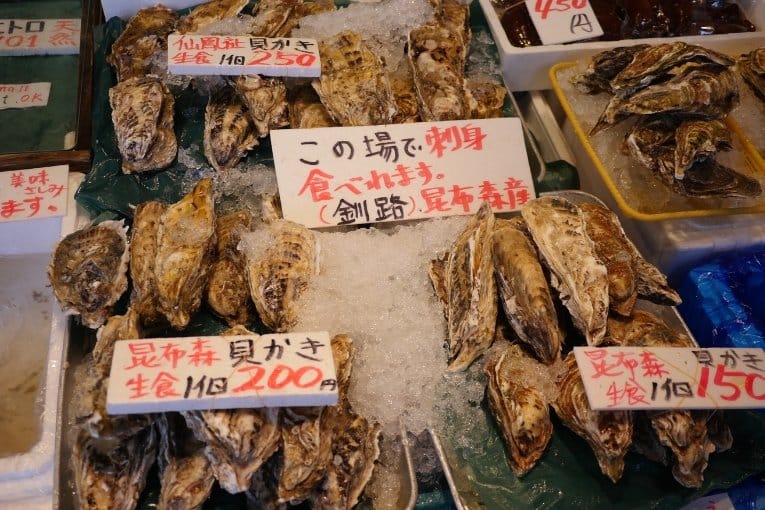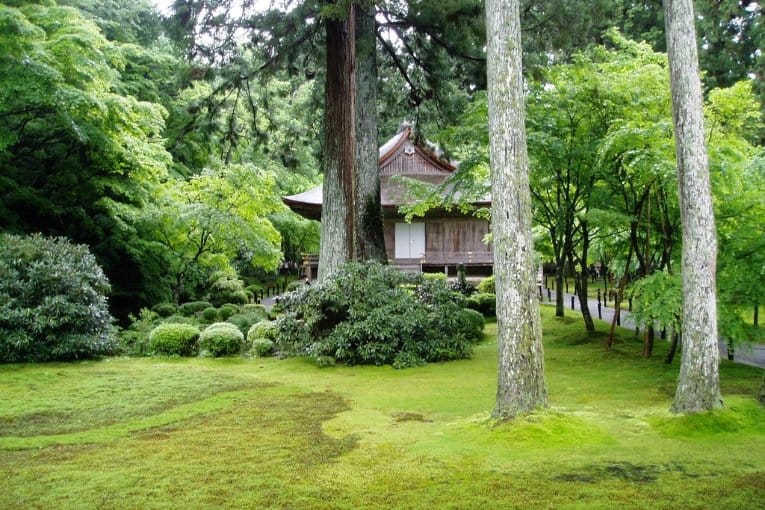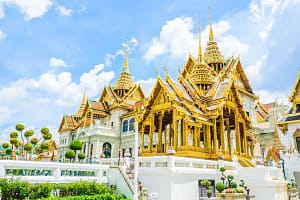Exploring Kyoto’s Timeless Charm: A Journey Through 41 Enchanting Attractions
Exploring the “Top 41 Tourist Attractions in Kyoto” is a way to explore Japan’s cultural heart for centuries. Kyoto, the ancient capital of Japan, is a city where each street and alleyway whispers tales from a thousand years of history. Unlike the fast-paced modernity of Tokyo, Kyoto moves to the serene rhythm of temple bells and the graceful steps of geisha in the Gion district. It’s a city where the past is preserved and celebrated with every festival. It has a meticulously maintained Zen garden and temple that are a testament to Japan’s rich cultural heritage. Here, the essence of traditional Japan is palpable, offering visitors a journey through time.
The beauty of Kyoto lies in its ability to blend the ancient with the contemporary, where traditional tea houses sit alongside modern cafes, and tranquil gardens are found just steps away from bustling city streets. As the seasons change, so does the city’s landscape, with cherry blossoms in spring and vibrant red maples in autumn framing the city’s stunning architecture. Kyoto’s temples, shrines, and historical sites are more than just attractions; they symbolize Japan’s enduring spiritual and aesthetic values.
From the golden reflections of Kinkaku-ji to the endless torii gates of Fushimi Inari Taisha, each site offers a unique glimpse into the traditions and artistry that shape Japanese culture. Whether you’re meandering through the Arashiyama Bamboo Grove or pondering the simplicity of a Zen garden, Kyoto promises a journey filled with beauty, contemplation, and discovery.
1. Kinkaku-ji (The Golden Pavilion)
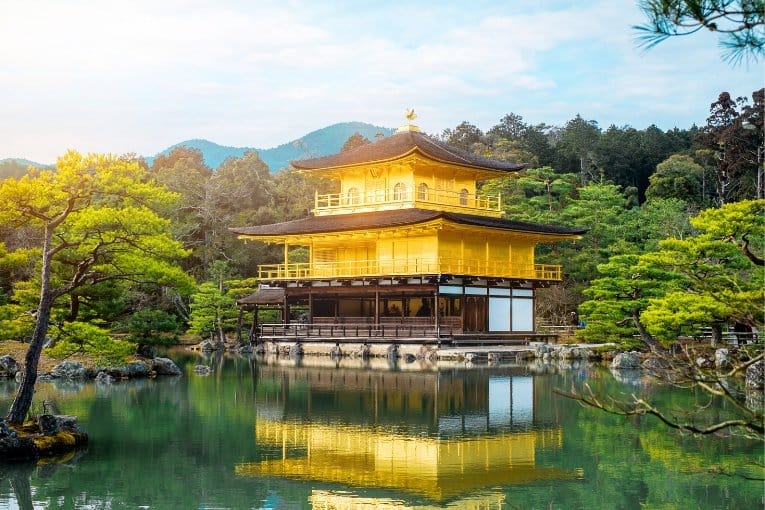
Kinkaku-ji, also known as the Golden Pavilion, is a historic and visually stunning Zen Buddhist temple in Kyoto. Its top two floors are entirely covered in gold leaf, shining brilliantly against the backdrop of the surrounding garden and reflecting pond. This architectural marvel, dating back to the Muromachi period, serves as a testament to the extravagant Kitayama culture that appreciated lavish displays of wealth.
- Trip Plan: Dedicate the first part of your day to exploring Kinkaku-ji, including its surrounding gardens.
- Trip Budget: Entry costs around $4 (400 JPY), with additional expenses for transportation and meals, likely bringing the total to about $20-30 USD for a visit.
- Best Time to Visit: The golden pavilion is a spectacle year-round, but it’s exceptionally breathtaking when framed by the cherry blossoms of early spring or the rich colors of autumn.
- Best Things to Do: Beyond admiring the pavilion, don’t miss the opportunity to stroll through the surrounding gardens and stop by the Sekka-tei Tea House for a moment of reflection.
- Nearest Airports: Osaka International Airport (Itami, ITM) is the closest domestic airport, while Kansai International Airport (KIX) serves international visitors.
- Transports to Use: Kyoto city buses are convenient and economical for reaching Kinkaku-ji from Kyoto Station.
- Near Tourist Attractions in Kyoto: Don’t miss the chance to visit Ryoan-ji Temple, located just a short distance away, famous for its Zen rock garden.
- Best Foods to Eat: Indulge in matcha-flavored treats available at tea houses around the temple.
- Best Places to Stay: The central Kyoto area offers a range of accommodations, from traditional ryokans to modern hotels, ensuring easy access to Kinkaku-ji and other historic sites.
- Travel Tips: To avoid the crowds and enjoy a more peaceful visit, aim to arrive early in the morning.
2. Fushimi Inari Taisha
Fushimi Inari Taisha is renowned for its seemingly endless path of over 10,000 vibrant torii gates that wind through the forested hillside of Mount Inari. Dedicated to Inari, the deity of rice and prosperity, the shrine features numerous fox statues, considered the messengers of the deity. The pathway up the mountain offers various stopping points with smaller shrines, tea shops, and stunning views over Kyoto, making it a spiritual and physical journey.
- Trip Plan: Allocate at least half a day to fully explore the shrine grounds and hike the Torii gate-covered trail up Mount Inari.
- Trip Budget: Visiting the shrine is free, but set aside $10-20 USD for snacks, souvenirs, or donations. If you plan to dine at a local restaurant, budget accordingly.
- Best Time to Visit: Early morning or late afternoon to avoid crowds; New Year for traditional festivities, but expect larger crowds.
- Best Things to Do: Hike to the summit of Mount Inari for a panoramic view of Kyoto, explore the smaller shrines along the path, and enjoy traditional Japanese street food from vendors along the way.
- Nearest Airports: Kansai International Airport (KIX) is for international travelers, and Itami Airport (ITM) is for domestic flights.
- Transports to Use: The JR Nara Line to Inari Station is the most direct route for those coming from Kyoto Station.
- Near Tourist Attractions in Kyoto: Tofuku-ji Temple, known for its stunning autumn leaves, is a short train ride away.
- Best Foods to Eat: Sample inari sushi and kitsune udon, which are considered fox spirits’ favorites.
- Best Places to Stay: Staying near Kyoto Station offers convenient access to Fushimi Inari Taisha and other attractions via public transport.
- Travel Tips: Wear comfortable shoes for the hike and bring water. Exploring the side paths can lead to less crowded and equally beautiful areas.
3. Arashiyama Bamboo Grove
The Arashiyama Bamboo Grove is one of Kyoto’s most enchanting and photographed sights, where paths wind through towering bamboo, creating a serene and otherworldly atmosphere. This natural wonder is part of the scenic district of Arashiyama, located on the western outskirts of Kyoto, an area known for its natural beauty, temples, and the historic Togetsukyo Bridge.
- Trip Plan: Reserve at least half a day to fully enjoy Arashiyama, including the Bamboo Grove, Tenryu-ji Temple, and a stroll across Togetsukyo Bridge.
- Trip Budget: The grove is free to enter. Budget around $20-30 USD for other site admissions, meals, and transport.
- Best Time to Visit: Early morning to experience the grove’s tranquility before the crowds or late afternoon for softer light.
- Best Things to Do: Walk through the bamboo grove, visit the nearby Tenryu-ji Temple, and take a rickshaw ride around Arashiyama.
- Nearest Airports: Kansai International Airport (KIX) for international flights; Itami Airport (ITM) for domestic connections.
- Transports to Use: The JR Sagano Line or the Hankyu Arashiyama Line to Arashiyama. The grove is a short walk from the station.
- Near Tourist Attractions in Kyoto: Tenryu-ji Temple, Okochi Sanso Villa, and the Monkey Park Iwatayama.
- Best Foods to Eat: Try yudofu (tofu hot pot) at a traditional restaurant or matcha-flavored desserts.
- Best Places to Stay: Stay in central Kyoto for easy access, or choose a traditional ryokan in Arashiyama for a local experience.
- Travel Tips: Visit during the week to avoid weekend crowds. The grove is particularly magical in the early morning light or when lit up at night during seasonal illuminations.
4. Kiyomizu-dera
Perched on the hillside of Eastern Kyoto, Kiyomizu-dera is a historic temple that offers breathtaking views over the city. The temple is best known for its wooden stage that juts out from the main hall, 13 meters above the hillside below. This UNESCO World Heritage site is a testament to traditional Japanese architecture, built without the use of nails. It is surrounded by stunning cherry and maple trees that offer vibrant colors in spring and autumn.
- Trip Plan: Allocate a morning or afternoon to explore Kiyomizu-dera and the surrounding Higashiyama district.
- Trip Budget: Entrance fee is around $4-6 USD. Include an additional $20-30 USD for souvenirs, snacks, and nearby site visits.
- Best Time to Visit: Cherry blossom season in spring or autumn for fall foliage. Early morning visits offer fewer crowds.
- Best Things to Do: Admire the view from the main hall, visit the Jishu Shrine dedicated to the deity of love, and walk down the historic Sannenzaka and Ninenzaka slopes nearby.
- Nearest Airports: Kansai International Airport (KIX) is for international use, and Itami Airport (ITM) is for domestic use.
- Transports to Use: Take the bus from Kyoto Station or the Keihan Line to Kiyomizu-Gojo Station, then walk or take a bus uphill.
- Near Tourist Attractions in Kyoto: Explore the historic streets of Sannenzaka and Ninenzaka, Kodai-ji Temple, and Yasaka Shrine.
- Best Foods to Eat: Sample local specialties like kaiseki ryori, Kyoto-style sushi, and matcha sweets from tea houses in Higashiyama.
- Best Places to Stay: Central Kyoto offers convenient access to accommodations in the Gion district for a traditional experience.
- Travel Tips: Wear comfortable shoes for walking the steep slopes of Higashiyama and visiting multiple sites.
5. Gion District
Gion is Kyoto’s most famous geisha district, characterized by its traditional wooden machiya houses. This area is rich in history and atmosphere, offering a glimpse into Kyoto’s past. Visitors can enjoy beautifully preserved streets, traditional tea houses, and a chance to see geiko (Kyoto dialect for geisha) and maiko (apprentice geisha) in their exquisite attire.
- Trip Plan: Spend an evening exploring the alleys of Gion. Consider booking a cultural show at Gion Corner or a private geiko entertainment experience in advance.
- Trip Budget: Walking through Gion is free, but attending a tea ceremony or cultural show may cost around $30-50 USD per person.
- Best Time to Visit: Dusk is magical in Gion when lanterns light up the streets, and you might catch a glimpse of geiko and maiko heading to appointments.
- Best Things to Do: Explore Hanami-koji Street, visit Kennin-ji Temple, and enjoy a traditional tea ceremony.
- Nearest Airports: Kansai International Airport (KIX) or Itami Airport (ITM).
- Transports to Use: Kyoto city buses or the Keihan Line to Gion-Shijo Station. Walking is the best way to explore Gion.
- Near Tourist Attractions in Kyoto: Yasaka Shrine, Maruyama Park, and the nearby Higashiyama district.
- Best Foods to Eat: Sample kaiseki ryori, Kyoto’s traditional multi-course meal, or enjoy matcha desserts in a local café.
- Best Places to Stay: Traditional ryokans in Gion or modern hotels in nearby areas like Kawaramachi.
- Travel Tips: Respect private properties and Geiko and Maiko’s privacy. Photography should be discreet.
6. The Path of Philosophy (Tetsugaku-no-michi)
The Philosopher’s Path is a stone path lined with hundreds of cherry trees, following a canal in Kyoto’s Higashiyama district. Named after Nishida Kitaro, a renowned Japanese philosopher who was said to meditate while walking this route on his daily commute to Kyoto University, the path offers a peaceful escape. It is particularly stunning during cherry blossom season.
- Trip Plan: Allocate 1-2 hours for a leisurely walk, starting from Ginkaku-ji (the Silver Pavilion) and ending in the Nanzen-ji temple area.
- Trip Budget: Free to walk; budget for snacks and admission fees to temples along the path.
- Best Time to Visit: Early April for cherry blossoms or autumn for colorful foliage.
- Best Things to Do: Visit Ginkaku-ji, contemplate the Zen gardens, and stop by the small shops and cafés along the path.
- Nearest Airports: Kansai International Airport (KIX) or Itami Airport (ITM).
- Transports to Use: The nearest subway stop is Keage on the Tozai Line, or use city buses to access Ginkaku-ji.
- Near Tourist Attractions in Kyoto: Ginkaku-ji, Nanzen-ji, and the nearby Eikando Temple.
- Best Foods to Eat: Try yatsuhashi (a cinnamon-flavored treat) or enjoy a cup of matcha at a teahouse along the path.
- Best Places to Stay: Stay in the Higashiyama area for easy access to the Philosopher’s Path and other cultural sites.
- Travel Tips: Early morning is less crowded. The path is also beautiful after rainfall, enhancing the tranquility of the experience.
7. Nijo Castle
Nijo Castle, a UNESCO World Heritage site, stands as a monument to the power of the Tokugawa shogunate during the Edo period. Its expansive grounds, beautiful gardens, and the Ninomaru Palace, with its ‘nightingale floors’ designed to sing at the slightest touch to warn of intruders, offer a fascinating glimpse into Japan’s feudal past. The castle’s opulent decoration and architecture contrast with the simplicity typically found in Japanese design, reflecting the shogun’s power.
- Trip Plan: Spend a few hours in the morning exploring the castle grounds, the palace interiors, and the surrounding gardens.
- Trip Budget: Admission is approximately $6-8 USD, with additional costs for guides or special exhibits.
- Best Time to Visit: Cherry blossom season in early April or fall for the changing leaves.
- Best Things to Do: Tour the Ninomaru Palace, walk through the castle gardens, and visit the tea house.
- Nearest Airports: Kansai International Airport (KIX) or Itami Airport (ITM).
- Transports to Use: The Kyoto City Subway to Nijojo-mae Station is the most direct route.
- Near Tourist Attractions in Kyoto: The Kyoto International Manga Museum and the Imperial Palace are nearby.
- Best Foods to Eat: Sample Kyoto cuisine at nearby traditional restaurants or cafes.
- Best Places to Stay: Central Kyoto accommodations offer convenience for exploring Nijo Castle and other attractions.
- Travel Tips: Wear socks; you’ll need to remove your shoes to enter Ninomaru Palace. Photography inside the palace is typically not allowed.
8. Kyoto Imperial Palace
The Kyoto Imperial Palace, once the residence of Japan’s Imperial Family, is now a public park area known as the Kyoto Gyoen National Garden. The palace complex showcases classical Japanese architecture and beautifully landscaped gardens. While the Imperial Family now resides in Tokyo, the Kyoto Imperial Palace remains a significant cultural and historical site, offering insight into the royal traditions of Japan.
- Trip Plan: Allocate half a day to explore the palace grounds and the surrounding gardens. Free guided tours are available but require advance registration.
- Trip Budget: Entry is free, but registration for a guided tour is recommended.
- Best Time to Visit: Spring for cherry blossoms or autumn for the changing leaves, both spectacular in the palace gardens.
- Best Things to Do: Join a guided tour of the main buildings and the imperial gardens.
- Nearest Airports: Kansai International Airport (KIX) or Itami Airport (ITM).
- Transports to Use: Easily accessible by Kyoto city buses or a short walk from Imadegawa Station on the Karasuma Subway Line.
- Near Tourist Attractions in Kyoto: The nearby Doshisha University campus and Kamogawa River provide pleasant walks.
- Best Foods to Eat: Enjoy traditional Japanese sweets from local shops around the Kyoto Gyoen National Garden.
- Best Places to Stay: Consider accommodations in central Kyoto for easy access to the palace and other cultural sites.
- Travel Tips: Check the Imperial Household Agency’s website for tour registration and palace closure days.
9. Sanjusangen-do Temple
Sanjusangen-do Temple is renowned for its impressive hall housing 1,001 statues of Kannon, the Buddhist goddess of mercy. The central image is flanked by a thousand life-sized wooden statues, each intricately carved and arranged in rows, creating an awe-inspiring sight. This temple holds the record for the longest wooden structure in Japan and is a testament to ancient Kyoto’s craftsmanship and religious devotion.
- Trip Plan: Dedicate 1-2 hours to fully appreciate the temple’s architecture and the rows of Kannon statues.
- Trip Budget: Entrance fee is around $5-6 USD—additional expenses for transportation and souvenirs.
- Best Time to Visit: Visit year-round, but early weekday morning to avoid crowds.
- Best Things to Do: Marvel at the 1,001 Kannon statues and explore the temple’s serene garden.
- Nearest Airports: Kansai International Airport (KIX) or Itami Airport (ITM) for international and domestic flights, respectively.
- Transports to Use: Easily accessible via Kyoto City Bus or a short walk from Shichijo Station on the Keihan Line.
- Near Tourist Attractions in Kyoto: The Kyoto National Museum and Tofuku-ji Temple’s beautiful Zen gardens.
- Best Foods to Eat: Sample vegetarian Buddhist cuisine (shojin ryori) available at nearby temples or traditional tea houses.
- Best Places to Stay: Accommodations in the Higashiyama district are close to Sanjusangen-do and other cultural sites.
- Travel Tips: Photography inside the main hall is prohibited, so be sure to soak in the sight with your eyes and memory.
10. Kyoto Botanical Gardens
The Kyoto Botanical Gardens, located in the northern part of the city, offers a lush escape with over 12,000 species of plants. The gardens feature a conservatory, various themed gardens, and spacious lawns perfect for picnicking. Each season brings a different aspect of beauty to the gardens, making it a year-round destination for nature lovers.
- Trip Plan: Spend a leisurely half-day wandering through the different sections of the garden, including the conservatory, cherry blossom trees, and the autumn leaf collection.
- Trip Budget: The garden entrance fee is around $2-3 USD, with a small additional cost for the conservatory.
- Best Time to Visit: Spring for cherry blossoms and azaleas, or autumn for the changing colors of the leaves.
- Best Things to Do: Enjoy the seasonal blooms, visit the conservatory, and relax by the Nakaragi-no-mori pond.
- Nearest Airports: Kansai International Airport (KIX) or Itami Airport (ITM).
- Transports to Use: Accessible via Kyoto City Bus or a short walk from Kitayama Station on the Karasuma Subway Line.
- Near Tourist Attractions in Kyoto: The Kamogawa River is perfect for a scenic stroll or bike ride.
- Best Foods to Eat: Pack a picnic to enjoy in the gardens or try the cafés near Kitayama Station for local Kyoto cuisine.
- Best Places to Stay: For easy access to the gardens and other natural attractions, consider staying in northern Kyoto.
- Travel Tips: Check the garden’s website for special events and blooming schedules to plan your visit around peak seasons.
11. Heian Shrine
Heian Shrine is a partial replica of the original Imperial Palace from the Heian Period, distinguished by its massive torii gate and expansive, serene gardens. The shrine’s architecture is a vivid orange and green, standing out against the peaceful backdrop of its surroundings. The gardens are a highlight, featuring a series of ponds, traditional bridges, and seasonal flowers that bloom throughout the year, making it a picturesque spot for leisure and reflection.
- Trip Plan: Allocate 2-3 hours to thoroughly explore the shrine and its gardens.
- Trip Budget: Entrance to the shrine is free, but the garden has an admission fee of about $6.
- Best Time to Visit: Spring for cherry blossoms and fall for autumn leaves, both spectacular in the shrine’s gardens.
- Best Things to Do: Stroll through the gardens, participate in traditional Shinto rituals at the shrine, and visit during festivals for cultural performances.
- Nearest Airports: Kansai International Airport (KIX) or Itami Airport (ITM).
- Transports to Use: Easily accessible via Kyoto’s bus system or a short walk from Higashiyama Station on the Tozai Line.
- Near Tourist Attractions in Kyoto: The Kyoto Municipal Museum of Art and the National Museum of Modern Art are nearby.
- Best Foods to Eat: Enjoy matcha and traditional Japanese sweets at a tea house within the shrine grounds.
- Best Places to Stay: Central Kyoto offers a variety of accommodation options, from modern hotels to traditional ryokans.
- Travel Tips: Visit early in the morning for a peaceful experience. Check the shrine’s event calendar for special ceremonies and festivals.
12. Yasaka Shrine
Yasaka Shrine, also known as Gion Shrine, is located at the end of Shijo-dori and is especially famous for its annual Gion Matsuri, one of Japan’s largest festivals. The shrine, featuring a dance stage with hundreds of lanterns, is vibrant day and night. It serves as a spiritual center for the Gion geisha district and is a popular spot for tourists and locals looking to soak in the traditional atmosphere of Kyoto.
- Trip Plan: Spend an hour at the shrine, and extend your visit into the evening to see the lanterns lit.
- Trip Budget: Visiting the shrine is free, but plan for additional costs to purchase omamori (amulets) or partake in cultural experiences in Gion.
- Best Time to Visit: July for the Gion Matsuri, though it’s a delightful visit year-round.
- Best Things to Do: Explore the shrine grounds, watch cultural performances on the dance stage, and enjoy the lively atmosphere of Gion at night.
- Nearest Airports: Kansai International Airport (KIX) or Itami Airport (ITM).
- Transports to Use: The Kyoto city bus system or a short walk from Gion-Shijo Station on the Keihan Line.
- Near Tourist Attractions in Kyoto: Explore the historic streets of Gion, Kennin-ji Temple, and the nearby Maruyama Park.
- Best Foods to Eat: Sample Kyoto cuisine in Gion, such as kaiseki dining, tofu specialties, and Kyoto sweets.
- Best Places to Stay: Stay in Gion or nearby Higashiyama, close to traditional Kyoto and its nightlife.
- Travel Tips: Evening visits offer a different ambiance with the lanterns lit; be respectful of local customs and privacy, especially when photographing geiko and maiko.
13. Kiyomizu-dera’s Otowa Waterfall
Situated at the base of Kiyomizu-dera Temple, Otowa Waterfall is divided into three separate streams, each believed to bestow different benefits: longevity, success in school, and a fortunate love life. Visitors use cups attached to long poles to drink from their chosen stream, adhering to the tradition that choosing all three is considered greedy. The waterfall, set against the backdrop of lush greenery and traditional temple architecture, offers a moment of reflection and is a testament to the temple’s connection with nature.
- Trip Plan: Visit after exploring Kiyomizu-dera Temple, allowing time to enjoy the tranquility of the waterfall and the surrounding area.
- Trip Budget: The Kiyomizu-dera entrance fee includes approximately $4-6 USD.
- Best Time to Visit: Early morning to avoid crowds; spring and autumn for the temple’s spectacular seasonal beauty.
- Best Things to Do: Participate in the water-drinking ritual, explore the temple grounds, and take in the panoramic views of Kyoto from the temple’s veranda.
- Nearest Airports: Kansai International Airport (KIX) for international flights; Itami Airport (ITM) for domestic travelers.
- Transports to Use: Kyoto City Bus or a walk from Kiyomizu-Gojo Station on the Keihan Line.
- Near Tourist Attractions in Kyoto: The historic streets of Sannenzaka and Ninenzaka, leading up to the temple, offer traditional shops and cafes.
- Best Foods to Eat: Sample yatsuhashi (a cinnamon-flavored treat) and matcha-flavored sweets from local vendors.
- Best Places to Stay: Accommodations in the Higashiyama district provide easy access to Kiyomizu-dera and other nearby attractions.
- Travel Tips: Remember to respect the ritual’s tradition by not drinking from all three streams. Early visits provide a more peaceful experience.
14. Eikando Zenrinji Temple
Eikando Zenrinji Temple is renowned for its stunning autumn colors and the statue of Mikaeri Amida, a unique depiction of the Buddha looking over his shoulder. The temple complex, nestled in the eastern mountains of Kyoto, offers a peaceful retreat with beautifully landscaped gardens, a pond, and several halls for meditation and worship. The temple’s night illuminations during the fall season attract visitors from all over Japan, creating a magical atmosphere.
- Trip Plan: Reserve at least 2-3 hours to explore the temple grounds fully and gardens and enjoy the tranquility.
- Trip Budget: Admission is around $6, with additional costs for special night viewings during the autumn illumination period.
- Best Time to Visit: Late November to early December for the autumn leaves; the temple is also beautiful during spring.
- Best Things to Do: Witness the unique Mikaeri Amida statue, stroll through the gardens, and attend the autumn night illuminations.
- Nearest Airports: Kansai International Airport (KIX) or Itami Airport (ITM).
- Transports to Use: Accessible by Kyoto city buses or a short walk from Keage Station on the Tozai Line.
- Near Tourist Attractions in Kyoto: Nanzenji Temple and the Philosopher’s Path are nearby and make for a lovely extended walk.
- Best Foods to Eat: Enjoy vegetarian Buddhist cuisine (shojin ryori) offered at the temple or nearby traditional restaurants.
- Best Places to Stay: Accommodations in the Higashiyama district are convenient for visiting Eikando and surrounding attractions.
- Travel Tips: The temple can be very crowded during the autumn illumination; it’s advisable to arrive early or book tickets in advance if possible.
15. To-ji Temple
To-ji Temple, a UNESCO World Heritage Site, is famous for its five-story pagoda, the highest wooden tower in Japan, symbolizing Kyoto’s ancient architectural achievements. The temple serves as a guardian of the city and is associated with Kobo Daishi (Kukai), one of Japan’s most significant religious figures. Its spacious grounds are home to various historically significant buildings and a thriving flea market held on the 21st of each month.
- Trip Plan: Spend a morning exploring the temple complex and pagoda, and if your visit aligns, explore the flea market.
- Trip Budget: Entry to the temple grounds is free, but entering the pagoda and certain halls may cost up to $5.
- Best Time to Visit: Spring for cherry blossoms and fall for colorful foliage; the 21st of each month for the flea market.
- Best Things to Do: Climb the pagoda for views, visit the Kobo Daishi Hall, and browse the flea market for antiques and local crafts.
- Nearest Airports: Kansai International Airport (KIX) is for international flights, and Itami Airport (ITM) is for domestic flights.
- Transports to Use: Easily reached by Kyoto’s Kintetsu Line, getting off at Toji Station.
- Near Tourist Attractions in Kyoto: Kyoto Aquarium and Umekoji Park are within walking distance and offer additional family-friendly activities.
- Best Foods to Eat: Sample local street food and Kyoto specialties at the flea market.
- Best Places to Stay: Central Kyoto for easy access to To-ji and other vital attractions; various options from budget to luxury are available.
- Travel Tips: Check the temple’s schedule for special events and ceremonies, especially during religious holidays.
16. Maruyama Park
Maruyama Park, Kyoto’s oldest public park, is famed for its sprawling landscapes that come alive with color in both spring and autumn. Centered around a large weeping cherry tree, which becomes a focal point during the cherry blossom season, the park transforms into a lively gathering spot for hanami (cherry blossom viewing) parties. Its proximity to Yasaka Shrine and numerous temples makes it a popular leisure spot for locals and tourists.
- Trip Plan: Plan to spend a leisurely afternoon or early evening in the park, which is exceptionally beautiful when the cherry blossoms are lit up at night during spring.
- Trip Budget: Free to visit; budget for food and drinks if you plan to enjoy a picnic or visit nearby teahouses.
- Best Time to Visit: Early April for cherry blossoms; late November for autumn foliage.
- Best Things to Do: Enjoy a hanami picnic under the cherry blossoms, stroll through the scenic paths, and visit Yasaka Shrine, located at the park’s edge.
- Nearest Airports: Kansai International Airport (KIX) or Itami Airport (ITM).
- Transports to Use: Easily accessible by bus from Kyoto Station or a short walk from Gion-Shijo Station on the Keihan Line.
- Near Tourist Attractions in Kyoto: Yasaka Shrine, Chion-in, and Kodai-ji are all within walking distance.
- Best Foods to Eat: Sample seasonal snacks from vendors in the park or dine in traditional restaurants in the nearby Gion district.
- Best Places to Stay: Accommodations in Gion or Higashiyama areas offer proximity to the park and a central location for exploring Kyoto.
- Travel Tips: The park can get crowded during peak blossom season; arrive early to find a good spot for picnics.
17. Kyoto Railway Museum
The Kyoto Railway Museum is an extensive facility dedicated to the history of Japan’s railways, from steam locomotives to the Shinkansen (bullet train). It features a vast collection of trains, interactive exhibits, and a railway diorama. The museum offers a fascinating insight into the technological advancements and the role of rail travel in Japan’s development.
- Trip Plan: Allocate at least half a day to explore the museum’s three floors of exhibits and outdoor display area and enjoy the simulators and railway-themed activities.
- Trip Budget: Admission is around $10 for adults, with discounts available for children and elderly people.
- Best Time to Visit: Year-round attraction, less crowded on weekdays.
- Best Things to Do: Climb aboard historic trains, try the train simulators, and watch the turntable demonstration.
- Nearest Airports: Kansai International Airport (KIX) or Itami Airport (ITM).
- Transports to Use: A short walk from Umekoji-Kyotonishi Station on the JR Sagano Line or a bus ride from Kyoto Station.
- Near Tourist Attractions in Kyoto: Umekoji Park and the Kyoto Aquarium are nearby, making for a full day of family-friendly activities.
- Best Foods to Eat: The museum café offers light meals and train-themed snacks. More dining options are available at Kyoto Station.
- Best Places to Stay: Stay near Kyoto Station for convenient access to the museum and excellent transport links to other parts of the city.
- Travel Tips: Check the museum’s schedule for special events or temporary exhibits that interest you.
18. Kyoto International Manga Museum
Photo Credit: Kento Ikeda / Flickr
The Kyoto International Manga Museum offers a deep dive into the world of Japanese manga, featuring an extensive collection that spans the history of manga from its origins to contemporary works. Visitors can read from a vast manga wall, enjoy temporary exhibitions highlighting manga’s cultural impact, and even encounter manga artists at work. The museum celebrates manga as an art form and explores its role in society and international reach.
- Trip Plan: Spend a few hours immersing yourself in manga history, reading works in the library, and exploring exhibitions.
- Trip Budget: Approximately $7 for general admission, with occasional special exhibits potentially costing extra.
- Best Time to Visit: Year-round; check for special exhibitions or artist meet-and-greet events in advance.
- Best Things to Do: Browse the manga wall, participate in a manga drawing workshop, and visit the museum shop for unique souvenirs.
- Nearest Airports: Kansai International Airport (KIX) or Itami Airport (ITM).
- Transports to Use: Easily reached by Kyoto City Bus or a short walk from Karasuma Oike Subway Station.
- Near Tourist Attractions in Kyoto: Nijo Castle and the Imperial Palace are within walking distance, offering a mix of historical exploration.
- Best Foods to Eat: The museum café serves light snacks and beverages; more dining options are available near Karasuma Oike Station.
- Best Places to Stay: Central Kyoto, particularly near the Karasuma and Oike areas, for easy access to the museum and other attractions.
- Travel Tips: Most manga are in Japanese, but the museum offers some English translations and guides to help non-Japanese speakers navigate the collection.
19. Kurama-dera Temple
Photo Credit: KENPEI / Wikipedia
Perched on the wooded slopes of Mount Kurama, Kurama-dera Temple is a serene spiritual site with a history that spans over a thousand years. The temple is associated with esoteric Buddhism and is believed to be a place of great spiritual power. The ascent to the temple offers breathtaking views of the surrounding mountains and valleys, making the journey as rewarding as the destination. The area is also famed for its hot springs, adding a relaxing element to the visit.
- Trip Plan: Allocate half a day to travel to Kurama, hike to the temple, and perhaps enjoy the hot springs afterward.
- Trip Budget: Entrance to the temple is about $3, with additional costs for the cable car, if chosen, and hot springs.
- Best Time to Visit: Autumn for spectacular foliage; the temple is enchanting year-round, especially during the Kurama Fire Festival in October.
- Best Things to Do: Hike the mountain path to the temple, participate in meditation sessions, and visit the Kurama Onsen to unwind.
- Nearest Airports: Kansai International Airport (KIX) or Itami Airport (ITM).
- Transports to Use: Take the Eizan Railway from Demachiyanagi Station in Kyoto to Kurama Station. The temple is a hike up from the station.
- Near Tourist Attractions in Kyoto: Explore the Kifune Shrine or enjoy hiking trails connecting Kurama to other parts of the mountain.
- Best Foods to Eat: Try local specialties at the small eateries near Kurama Station, including soba noodles and yuba dishes.
- Best Places to Stay: Kyoto City provides a broad range of accommodation options; ryokans near Kurama are ideal for a closer stay.
- Travel Tips: Wear comfortable shoes for the hike and bring water. The cable car can shorten the journey, but walking offers the best experience.
20. Tofuku-ji Temple
Tofuku-ji Temple is a historic Zen Buddhist temple renowned for its stunning autumn foliage, particularly around its iconic Tsutenkyo Bridge. The temple, established in the 13th century, is one of Kyoto’s five great Zen temples and boasts a large complex with beautiful gardens designed by the famous landscape architect Mirei Shigemori. Its sprawling grounds offer a serene atmosphere, inviting contemplation and exploration.
- Trip Plan: Allocate 2-3 hours to explore the temple’s various gardens and buildings, with extra time during autumn to admire the foliage.
- Trip Budget: Admission varies by season, with roughly $4 for garden access and additional fees for special openings.
- Best Time to Visit: Late November for the peak of autumn colors; the temple is also beautiful in spring and summer.
- Best Things to Do: Walk across Tsutenkyo Bridge, visit the Hojo with its Zen rock garden, and explore the four gardens at each compass point around the Hojo.
- Nearest Airports: Kansai International Airport (KIX) or Itami Airport (ITM).
- Transports to Use: Accessible by JR Nara Line from Kyoto Station to Tofukuji Station; the temple is a short walk from there.
- Near Tourist Attractions in Kyoto: Fushimi Inari Shrine is nearby, making for a good combined trip.
- Best Foods to Eat: Enjoy vegetarian Zen cuisine (shojin ryori) at nearby temple lodgings or local cafes.
- Best Places to Stay: Stay in central Kyoto for easy access to Tofuku-ji and other major sites.
- Travel Tips: The temple can get crowded during the autumn foliage season, so visiting early in the morning is recommended.
21. Kyoto National Museum
Photo Credit: Wiiii / Wikipedia
The Kyoto National Museum is one of Japan’s premier cultural institutions, housing an extensive collection of art pieces and artifacts that span Japan’s historical periods. The museum’s exhibitions focus on traditional Japanese art, including ceramics, sculptures, paintings, and calligraphy, offering insights into the country’s rich artistic heritage. The museum’s Heisei Chishinkan, designed by architect Taniguchi Yoshio, is a modern contrast to the otherwise traditional ambiance of Kyoto.
- Trip Plan: Dedicate half a day to explore the museum’s permanent and temporary exhibitions thoroughly.
- Trip Budget: Admission is about $5-10 USD, depending on the exhibition.
- Best Time to Visit: Year-round; check the museum’s website for special exhibitions that might coincide with your visit.
- Best Things to Do: Explore the museum’s collections, attend a cultural workshop or lecture, and stroll through the museum grounds.
- Nearest Airports: Kansai International Airport (KIX) or Itami Airport (ITM).
- Transports to Use: Easily reached by bus from Kyoto Station or a short walk from Shichijo Station on the Keihan Line.
- Near Tourist Attractions in Kyoto: Sanjusangen-do Temple and the Shosei-en Garden are within walking distance.
- Best Foods to Eat: Sample Kyoto cuisine at restaurants around the museum or try traditional sweets from local confectioneries.
- Best Places to Stay: Accommodations in the Higashiyama district are convenient for exploring the museum and nearby cultural sites.
- Travel Tips: The museum is closed on Mondays (or the following day if Monday is a national holiday), so plan your visit accordingly.
22. Kamogawa River
The Kamogawa River, running through Kyoto, is more than just a body of water; it’s a vibrant part of the city’s life. With walking paths along both banks, the river is a popular spot for locals and tourists alike to stroll, dine, and gather, especially during the warmer months. Restaurants with terraces open up along the river, offering a dining experience with scenic views. The river’s presence adds a serene beauty to Kyoto, making it a perfect place for leisurely walks and moments of reflection.
- Trip Plan: Spend a relaxed evening walking along the riverbanks, perhaps starting from the downtown area and moving northward, where the scenery becomes more tranquil.
- Trip Budget: Free to enjoy the walk; dining costs vary by restaurant, but expect to spend around $20-40 USD for a meal with a view.
- Best Time to Visit: Spring and autumn are suitable for pleasant weather; summer evenings are lively with open-air dining terraces.
- Best Things to Do: Enjoy a meal at one of the riverside restaurants, take a leisurely walk to admire the cityscape, and watch traditional performances in the Minami-za Kabuki Theatre near the river.
- Nearest Airports: Kansai International Airport (KIX) or Itami Airport (ITM).
- Transports to Use: The river is easily accessible on foot from many parts of central Kyoto, including Gion and downtown.
- Near Tourist Attractions in Kyoto: Gion district, Pontocho Alley, and the Kyoto Imperial Palace are all within walking distance.
- Best Foods to Eat: Sample Kyoto cuisine at a riverside restaurant or enjoy casual street food from nearby vendors.
- Best Places to Stay: Central Kyoto offers a wide range of accommodations, from luxury hotels to budget-friendly guesthouses, with easy access to the river.
- Travel Tips: Evening strolls are particularly magical, especially when lit by riverside lanterns.
23. Iwatayama Monkey Park
Located in the scenic Arashiyama district, Iwatayama Monkey Park is home to a troop of over 120 Japanese macaques (snow monkeys). The park offers a unique opportunity to observe these animals in a semi-wild environment. A short hike up the mountain brings visitors face-to-face with the monkeys and offers panoramic views of Kyoto. The monkeys roam freely, providing a rare chance for close encounters in a respectful and natural setting.
- Trip Plan: Allow 2-3 hours for the hike and ample time at the top to enjoy the views and monkey interactions.
- Trip Budget: Admission is about $5 per person, with additional costs for transportation and snacks.
- Best Time to Visit: Year-round, though the views are particularly striking during cherry blossom season and autumn.
- Best Things to Do: Feed the monkeys from the designated feeding area, take photos (with rules for respect and safety), and enjoy the stunning views of Kyoto from the park’s viewpoint.
- Nearest Airports: Kansai International Airport (KIX) or Itami Airport (ITM).
- Transports to Use: The park is a short walk from the Arashiyama district, accessible by train or bus from central Kyoto.
- Near Tourist Attractions in Kyoto: Arashiyama Bamboo Grove, Tenryu-ji Temple, and the scenic Togetsukyo Bridge are nearby.
- Best Foods to Eat: Try local snacks and dishes in Arashiyama before or after your visit to the park.
- Best Places to Stay: Stay in Arashiyama for a serene experience close to nature or in central Kyoto for broader city exploration.
- Travel Tips: Wear comfortable shoes for the hike and follow the park’s guidelines for interacting with the monkeys to ensure a safe visit for everyone.
24. Nishiki Market
Known as “Kyoto’s Kitchen,” Nishiki Market is a bustling five-block-long shopping street lined with more than one hundred shops and restaurants. This vibrant market specializes in all things food – from fresh seafood and produce to Japanese sweets and pickles. It’s not just a place to buy ingredients; it’s a culinary adventure, offering a glimpse into the local lifestyle and Kyoto’s gastronomic culture. Visitors can sample traditional foods, learn about Japanese cooking ingredients, and find unique souvenirs.
- Trip Plan: Dedicate a couple of hours to explore the market, ideally around lunchtime, to take advantage of the various food samples and snacks.
- Trip Budget: Browsing is free, but set aside $10-30 USD for food tastings and souvenirs.
- Best Time to Visit: Morning or early afternoon when all shops are open; avoid national holidays and Wednesdays when some shops may be closed.
- Best Things to Do: Sample local specialties like Kyoto pickles, fresh tofu, and matcha-flavored sweets. Don’t miss the chance to try dashimaki tamago, a local version of the Japanese omelet.
- Nearest Airports: Kansai International Airport (KIX) or Itami Airport (ITM).
- Transports to Use: Easily accessible on foot from Shijo Station on the Karasuma Subway Line or Kawaramachi Station on the Hankyu Line.
- Near Tourist Attractions in Kyoto: Just a short walk from the Gion district, allowing for a combined cultural and culinary exploration.
- Best Foods to Eat: Indulge in street food offerings like skewered octopus, sushi, and Kyoto-style pancakes.
- Best Places to Stay: Central Kyoto, particularly near the Shijo-Kawaramachi area, for proximity to both the market and other city attractions.
- Travel Tips: Bring cash, as many stalls do not accept credit cards. Be mindful of the crowds and narrow spaces, especially when the market is busy.
25. Fushimi Inari Shrine’s Bamboo Forest
While the thousands of vermilion torii gates are the main draw of Fushimi Inari Shrine, the shrine’s lesser-known bamboo forest offers a tranquil and mystical experience. Tucked away on the shrine’s extensive grounds, this bamboo grove provides a quieter alternative to the more crowded Arashiyama Bamboo Grove.
- Trip Plan: Incorporate a visit to the bamboo forest as part of your exploration of Fushimi Inari Shrine, setting aside time to immerse yourself in the tranquility fully.
- Trip Budget: There is no admission fee for Fushimi Inari Shrine or its bamboo forest, but a budget for transportation and any offerings you wish to make at the shrine.
- Best Time to Visit: In the early morning, enjoy the bamboo forest in solitude or in the late afternoon, when the light filters softly through the bamboo.
- Best Things to Do: Take a reflective walk through the bamboo grove, explore the shrine’s many sub-shrines, and hike up Mount Inari for panoramic views.
- Nearest Airports: Kansai International Airport (KIX) or Itami Airport (ITM) are gateways for international and domestic visitors.
- Transports to Use: The JR Nara Line to Inari Station is the most direct route from Kyoto Station to Fushimi Inari Shrine.
- Near Tourist Attractions in Kyoto: Tofuku-ji Temple, with its stunning Zen gardens and autumn colors, is nearby and worth a visit.
- Best Foods to Eat: Sample street food from vendors along the shrine paths, including inari sushi and kitsune udon, considered favorites of the deity Inari.
- Best Places to Stay: Accommodations in southern Kyoto or near Kyoto Station offer convenient access to Fushimi Inari and other major sights.
- Travel Tips: Wear comfortable shoes for walking and hiking, and bring water, especially if you plan to hike to the summit of Mount Inari.
26. Kyoto Aquarium
The Kyoto Aquarium, located in Umekoji Park near Kyoto Station, is a modern facility that offers an insight into the aquatic life of Japan and beyond. The aquarium is notable for its conservation efforts and educational programs. It features a variety of exhibits, including a large tank for dolphins, zones dedicated to the aquatic life of Kyoto’s rivers, and a penguin habitat. It’s an excellent place for families and anyone interested in marine biology and conservation.
- Trip Plan: Plan a half-day visit to enjoy the aquarium’s many exhibits and scheduled dolphin shows.
- Trip Budget: Admission is approximately $18 for adults, with discounts for children, students, and elderly people.
- Best Time to Visit: Year-round indoor exhibits offer a break from Kyoto’s hot summers or cold winters.
- Best Things to Do: Don’t miss the dolphin performances, the interactive touch pools, and the Kyoto Rivers exhibit.
- Nearest Airports: Kansai International Airport (KIX) for international flights; Itami Airport (ITM) for domestic flights.
- Transports to Use: A short walk from Kyoto Station or accessible via the city’s bus network.
- Near Tourist Attractions in Kyoto: Umekoji Park and the Kyoto Railway Museum are nearby, making a day full of diverse experiences.
- Best Foods to Eat: The aquarium has a café serving light meals and snacks; Kyoto Station nearby offers a wide range of dining options.
- Best Places to Stay: Staying near Kyoto Station provides easy access to the aquarium and excellent transport links to explore the rest of the city.
- Travel Tips: Plan your visit by checking the aquarium’s schedule for show times and special events.
27. Okochi Sanso Villa
Okochi Sanso Villa is the former residence of the famous Japanese actor Denjiro Okochi, best known for his samurai films. Nestled in the scenic Arashiyama district, the villa’s meticulously maintained Japanese gardens offer breathtaking views of Kyoto and the surrounding mountains. Visitors can stroll through the serene landscape.
- Trip Plan: Allocate around 1-2 hours to explore the villa and gardens, culminating with a visit to the tea house for matcha and sweets included in the admission fee.
- Trip Budget: Admission is approximately $10, including tea and a snack at the tea house.
- Best Time to Visit: The gardens are beautiful year-round, but they are particularly stunning during cherry blossom season in spring and when the maple leaves change color in autumn.
- Best Things to Do: Enjoy the panoramic views from the highest point in the garden, visit the museum dedicated to Denjiro Okochi’s life and career, and relax at the tea house with traditional Japanese green tea.
- Nearest Airports: Kansai International Airport (KIX) for international arrivals; Itami Airport (ITM) for domestic flights.
- Transports to Use: Easily accessible by Kyoto bus services from Kyoto Station or a scenic walk from Arashiyama’s main street.
- Near Tourist Attractions in Kyoto: The Bamboo Grove and Tenryu-ji Temple are within walking distance, making for a full day of exploration in Arashiyama.
- Best Foods to Eat: Enjoy traditional matcha green tea and Japanese sweets at the villa’s tea house, reflecting the area’s culinary traditions.
- Best Places to Stay: Consider staying in the Arashiyama area for easy access to its natural beauty and attractions or in central Kyoto for broader exploration.
- Travel Tips: The villa can be quite peaceful early in the morning or late in the afternoon, offering a more intimate experience of the gardens.
28. Kyoto Imperial Park (Kyoto Gyoen)
Surrounding the Kyoto Imperial Palace, Kyoto Imperial Park (Kyoto Gyoen) is a large public park serving as a green oasis in the city’s heart. It’s spacious, with wide gravel paths, lush lawns, and well-maintained gardens. The park is a place for leisure and picnics, and it is a historical site that offers a glimpse into the imperial family’s past.
- Trip Plan: Spend a leisurely morning or afternoon in the park, perhaps bringing a picnic under the trees.
- Trip Budget: Free to explore, with costs only for food or special events within the park.
- Best Time to Visit: Beautiful in all seasons, with cherry blossoms in spring and colorful foliage in autumn being particularly noteworthy.
- Best Things to Do: Take a leisurely walk or jog around the park, visit the various gardens, and explore the outer walls of the Imperial Palace.
- Nearest Airports: Kansai International Airport (KIX) is for international travelers, and Itami Airport (ITM) is for those flying domestically.
- Transports to Use: The park is centrally located and easily accessible on foot from multiple subway and bus stops around Kyoto.
- Near Tourist Attractions in Kyoto: The Kyoto Imperial Palace, Sento Imperial Palace, and the Kaninnomiya Mansion are located within or near the park.
- Best Foods to Eat: Pack a picnic with local Kyoto delicacies from nearby markets, or enjoy a meal at one of the many cafes and restaurants surrounding the park.
- Best Places to Stay: Central Kyoto, near the Imperial Palace, offers easy access to the park and other significant sites in the city.
- Travel Tips: The park is ideal for a quiet escape from the city’s hustle and bustle; look out for cultural events and flower exhibitions often held there.
29. Ninna-ji Temple
Ninna-ji Temple, a UNESCO World Heritage site, is one of the historic monuments of ancient Kyoto. Founded in the 9th century, it served as a residence for retired emperors, blending imperial grandeur with religious solemnity. The temple is renowned for its late-blooming cherry trees, the Omuro Sakura, and its five-story pagoda, which adds to the picturesque landscape. The head priest’s former residence, the Goten, resembles an imperial palace with elegantly designed rooms and a beautiful, serene garden.
- Trip Plan: Allocate 2-3 hours to explore the temple grounds, the Goten, and the gardens.
- Trip Budget: Entrance to the temple grounds is free, but there’s a fee of around $6 to enter the Goten.
- Best Time to Visit: Mid-April is the time for the Omuro Sakura cherry blossoms; the peaceful gardens are beautiful year-round.
- Best Things to Do: Admire the cherry blossoms, visit the five-story pagoda, and explore the elegant rooms and gardens of the Goten.
- Nearest Airports: Kansai International Airport (KIX) or Itami Airport (ITM).
- Transports to Use: Accessible by city bus from Kyoto Station or via the Randen tram line, getting off at Omuro Ninnaji Station.
- Near Tourist Attractions in Kyoto: Ryoan-ji and Kinkaku-ji are nearby, making for a comprehensive exploration of Kyoto’s northwest.
- Best Foods to Eat: Sample vegetarian Buddhist cuisine at nearby temple lodgings or enjoy traditional Kyoto dishes in the surrounding area.
- Best Places to Stay: The Arashiyama or central Kyoto areas offer convenient access to Ninna-ji and other major attractions.
- Travel Tips: The temple can be crowded during cherry blossom season; visit early in the morning to avoid crowds.
30. Shoren-in Temple
Shoren-in Temple, located in the Higashiyama district near the southern end of the Philosopher’s Path, is one of the five Monzeki temples of the Tendai sect in Kyoto. Traditionally, its head priests were members of the imperial family. Shoren-in impresses with its tranquil atmosphere, beautiful gardens, and night-time illuminations that transform the temple and its surroundings into a magical scene. The temple’s main hall allows visitors to sit and contemplate the peaceful garden views, promoting a moment of Zen-like serenity.
- Trip Plan: Plan to spend 1-2 hours at the temple, especially beautiful during the evening illumination events.
- Trip Budget: Admission is about $5, with special events and night illuminations potentially costing extra.
- Best Time to Visit: Spring and autumn are suitable for night-time illuminations; the temple offers a peaceful retreat year-round.
- Best Things to Do: Enjoy the tranquil gardens, participate in a meditation session if available, and visit during evening illuminations.
- Nearest Airports: Kansai International Airport (KIX) or Itami Airport (ITM).
- Transports to Use: A short walk from Higashiyama Station on the Tozai Line or accessible via Kyoto’s bus network.
- Near Tourist Attractions in Kyoto: Close to Chion-in and the start of the Philosopher’s Path, making it an ideal part of a larger exploration.
- Best Foods to Eat: Discover local tea houses and cafes along the Philosopher’s Path, serving matcha and traditional Kyoto sweets.
- Best Places to Stay: The Higashiyama area offers a range of accommodations, from traditional ryokans to modern hotels.
- Travel Tips: Check the temple’s schedule for special events and night illuminations, which offer a unique way to experience its beauty.
31. Yasui Konpiragu Shrine
Yasui Konpiragu Shrine is known for its unique power stone, which is believed to sever bad relationships and initiate good ones. This lesser-known shrine attracts those seeking to change their relational fortunes. Visitors write their wishes on special paper, then crawl through a hole in the middle of the stone and back, symbolizing the severance of bad ties and the beginning of new, positive connections. The shrine, set in the heart of Gion, provides a tranquil spot amidst the bustling district.
- Trip Plan: Spend an hour at the shrine, partaking in the rituals and exploring the serene grounds.
- Trip Budget: The shrine is free to visit, with small fees for ema (wish plaques) or other omamori (amulets).
- Best Time to Visit: Year-round; it’s particularly poignant for those undergoing life transitions.
- Best Things to Do: Participate in the unique ritual of passing through the power stone, exploring the shrine grounds, and soaking in the peaceful atmosphere.
- Nearest Airports: Kansai International Airport (KIX) or Itami Airport (ITM).
- Transports to Use: Easily reached by foot from Gion or a short bus ride from Kyoto Station.
- Near Tourist Attractions in Kyoto: Located in Gion, close to Kennin-ji Temple and the bustling streets of Hanami-koji.
- Best Foods to Eat: Gion offers a variety of dining options, from traditional Kyoto kaiseki to casual street food.
- Best Places to Stay: Gion and surrounding areas offer accommodations that range from luxury ryokans to budget guesthouses.
- Travel Tips: Visit early in the morning or late in the afternoon to avoid crowds and experience the shrine’s tranquility.
32. Kodai-ji Temple
Photo Credit: josef knecht / Wikipedia
Established in 1606 in memory of Toyotomi Hideyoshi, Kodai-ji Temple showcases the zenith of Momoyama culture through its stunning architecture, gardens, and art collections. The temple’s grounds feature beautiful Zen gardens, including a rock garden and a tsukiyama-style garden with a small pond. Kodai-ji’s main hall is adorned with lavish gold leaf and elaborate lacquerwork, embodying the luxury of the era. Night-time illuminations highlight the gardens’ beauty, creating a mystical atmosphere.
- Trip Plan: Allocate 2 hours to fully appreciate the temple architecture, gardens, and the bamboo grove.
- Trip Budget: The entrance fee is around $9, with additional costs for special exhibitions or night illuminations.
- Best Time to Visit: Spring for cherry blossoms and autumn for night illuminations that beautifully showcase the fall foliage.
- Best Things to Do: Explore the Zen gardens, visit the tea houses within the temple grounds, and enjoy the seasonal illuminations.
- Nearest Airports: Kansai International Airport (KIX) or Itami Airport (ITM).
- Transports to Use: Walkable from Higashiyama or Gion-Shijo Stations or a short bus ride from Kyoto Station.
- Near Tourist Attractions in Kyoto: Close to Yasaka Shrine and Maruyama Park, it is perfect for exploring Kyoto’s cultural heritage.
- Best Foods to Eat: Try yuba (tofu skin) dishes and matcha sweets in the nearby tea houses or restaurants.
- Best Places to Stay: The Higashiyama area offers various lodging options, from traditional inns to contemporary hotels.
- Travel Tips: The temple grounds can be steep; wear comfortable shoes for exploring.
33. Umekoji Park
Photo Credit: Chris Gladis / Flickr
Umekoji Park is a spacious green oasis just a short distance from Kyoto Station. This park is known for its large, open lawns, seasonal flower displays, and the Kyoto Aquarium, making it a perfect spot for families and anyone looking to relax amidst nature. The park also houses the Kyoto Railway Museum, offering educational and leisure activities. With walking paths, picnic areas, and playgrounds, Umekoji Park provides a serene escape from the bustling city.
- Trip Plan: Plan a leisurely half-day visit to explore the park and its attractions, perfect for a picnic or a leisurely stroll.
- Trip Budget: The park itself is free to enter, but attractions within the park, like the Kyoto Aquarium and the Railway Museum, have separate admission fees.
- Best Time to Visit: Spring for cherry blossoms and autumn for colorful foliage, though the park is welcoming year-round.
- Best Things to Do: Visit the Kyoto Aquarium and the Railway Museum, enjoy a picnic on the lawns, and let children play in the designated areas.
- Nearest Airports: Kansai International Airport (KIX) or Itami Airport (ITM).
- Transports to Use: A short walk from Kyoto Station, making it easily accessible by bus, train, or on foot.
- Near Tourist Attractions in Kyoto: The Kyoto Tower and Higashi Honganji Temple are nearby, offering a mix of modern and traditional experiences.
- Best Foods to Eat: Bring your own picnic or enjoy snacks from vendors within the park and nearby convenience stores.
- Best Places to Stay: Staying near Kyoto Station offers convenience for exploring Umekoji Park and other city attractions.
- Travel Tips: Check the schedules for the Kyoto Aquarium and Railway Museum in advance, especially for special events or exhibits.
34. Ginkaku-ji (The Silver Pavilion)
Ginkaku-ji, the Silver Pavilion, is a Zen temple along Kyoto’s eastern mountains, representing the Higashiyama Culture of the Muromachi period. Unlike its golden counterpart, the pavilion isn’t adorned in silver but is celebrated for its subtle yet profound beauty. The temple complex includes a dry sand garden known as the “Sea of Silver Sand,” a moss garden, and wooded areas, offering a tranquil and meditative space. The pavilion, set against Kyoto’s lush mountains, reflects the Japanese wabi-sabi aesthetic, finding beauty in simplicity and impermanence.
- Trip Plan: Spend an hour or two exploring the temple grounds, gardens, and the Togudo, which houses fascinating artifacts.
- Trip Budget: Entry fees are around $6, with additional spending for souvenirs or tea.
- Best Time to Visit: Late March to early April for cherry blossoms and November for autumn colors.
- Best Things to Do: Walk the circular route around the grounds to appreciate the garden’s design, and visit the Togudo, part of the original residential area.
- Nearest Airports: Kansai International Airport (KIX) or Itami Airport (ITM).
- Transports to Use: Easily accessible by bus from Kyoto Station or a short walk from nearby bus stops.
- Near Tourist Attractions in Kyoto: The Philosopher’s Path starts here, leading towards other notable sites like Honen-in and Nanzen-ji Temples.
- Best Foods to Eat: Try matcha tea and traditional Japanese sweets at a tea house within the temple complex.
- Best Places to Stay: Accommodations in the Higashiyama district offer easy access to Ginkaku-ji and the Philosopher’s Path.
- Travel Tips: Early morning visits provide a more peaceful experience, as it can get crowded, especially during peak seasons.
35. Kyoto International Conference Center
The Kyoto International Conference Center, located in the northern part of the city near Takaragaike Park, is an architectural marvel and a landmark of modernist design. It gained international fame as the site of the 1997 Kyoto Protocol signing. The center is surrounded by serene landscapes, offering a unique blend of nature and architecture. Its design, emphasizing harmony with the surrounding environment, makes it a fascinating visit for those interested in architecture, history, or international affairs.
- Trip Plan: Allocate 2-3 hours to explore the center’s architecture and the adjacent park.
- Trip Budget: The center is free to explore, though specific events or conferences may have entry fees.
- Best Time to Visit: Year-round, the surrounding park offers seasonal beauty.
- Best Things to Do: Tour the facility to appreciate its architectural significance, attend public events or exhibitions, and enjoy a stroll in Takaragaike Park.
- Nearest Airports: Kansai International Airport (KIX) or Itami Airport (ITM).
- Transports to Use: Accessible by subway, getting off at Kokusaikaikan Station on the Karasuma Line.
- Near Tourist Attractions in Kyoto: Explore the nearby Takaragaike Park for a peaceful nature walk.
- Best Foods to Eat: Dining options within the conference center and its immediate vicinity offer Japanese and international cuisine.
- Best Places to Stay: Northern Kyoto has several hotels and ryokans, providing easy access to the conference center and a quieter stay away from the city center.
- Travel Tips: Check the conference center’s schedule online to learn about any public events, exhibitions, or guided tours available during your visit.
36. Togetsukyo Bridge
Togetsukyo Bridge, meaning “Moon Crossing Bridge,” is a historic and iconic structure spanning the Katsura River in the scenic Arashiyama district of Kyoto. Initially built in the Heian period and reconstructed in the 1930s, this bridge offers picturesque views of the surrounding mountains and river, making it a popular spot for tourists and photographers alike. The area around Togetsukyo is renowned for its natural beauty, particularly during cherry blossom season and autumn when the foliage turns vivid hues of red and orange.
- Trip Plan: Allocate about an hour to walk across the bridge and explore the nearby riverbanks and parks.
- Trip Budget: There is no cost to walk across the bridge; budget for any nearby attractions or boat rentals to enjoy the river up close.
- Best Time to Visit: Spring for cherry blossoms and autumn for the changing leaves; summer provides lush greenery and traditional cormorant fishing demonstrations.
- Best Things to Do: Take a leisurely stroll across the bridge, rent a boat to enjoy the river, and explore the nearby Tenryu-ji Temple and bamboo groves.
- Nearest Airports: Kansai International Airport (KIX) or Itami Airport (ITM).
- Transports to Use: Easily reached by train to Arashiyama Station or by bus from central Kyoto.
- Near Tourist Attractions in Kyoto: Close to the Arashiyama Bamboo Grove, Iwatayama Monkey Park, and Tenryu-ji Temple.
- Best Foods to Eat: Sample local specialties like yudofu (tofu hot pot) and matcha sweets in the Arashiyama area.
- Best Places to Stay: Staying in Arashiyama offers a serene experience close to nature, with several traditional inns and modern hotels available.
- Travel Tips: Early morning or late afternoon visits offer softer light for photography and a more peaceful experience.
37. Saiho-ji (Moss Temple)
Photo Credit: kajikawa / Wikipedia
Saiho-ji, popularly known as the Moss Temple, is renowned for its beautiful moss garden, which features over 120 types of moss. This Zen Buddhist temple, a UNESCO World Heritage Site, offers a unique and meditative experience unlike any other in Kyoto. The lush green carpet of moss, combined with the serene pond and traditional temple architecture, creates a tranquil and mystical atmosphere. Visitors are required to participate in a Zen ritual, including chanting and writing wishes before exploring the gardens.
- Trip Plan: Allocate 2-3 hours for the visit, including the Zen ritual and garden exploration.
- Trip Budget: Admission is around $30, which includes the ritual participation and garden tour. Advance reservations are required.
- Best Time to Visit: The moss garden is lush and vibrant year-round, with the rainy season (June to July) being particularly magical.
- Best Things to Do: Engage in the Zen ritual, meditate by the pond, and wander through the moss-covered garden paths.
- Nearest Airports: Kansai International Airport (KIX) or Itami Airport (ITM).
- Transports to Use: Accessible by Kyoto city buses; a reservation confirmation will provide specific instructions.
- Near Tourist Attractions in Kyoto: Close to Arashiyama’s bamboo groves and other temples, making it part of a broader exploration of the area.
- Best Foods to Eat: Traditional tea houses in the area offer matcha and Japanese sweets, perfect after a peaceful garden visit.
- Best Places to Stay: The Arashiyama area allows easy access to Saiho-ji and a serene environment.
- Travel Tips: Ensure you make a reservation well in advance, as Saiho-ji requires all visitors to apply and receive confirmation due to its limited entry policy.
38. Kitano Tenmangu Shrine
Kitano Tenmangu Shrine is dedicated to Sugawara no Michizane, a scholar and politician worshipped as the god of learning. It’s a popular spot for students praying for success in exams. The shrine is also famous for its plum blossom garden, with hundreds of plum trees blooming vibrantly in early spring. The Tenjin-san Market, held on the 25th of each month, is a bustling event where visitors can find antiques, crafts, and street food.
- Trip Plan: Visit during the plum blossom season or on the 25th for the market, spending 1-2 hours at the shrine.
- Trip Budget: Free to enter the shrine; budget for market purchases or special garden openings.
- Best Time to Visit: Early spring for plum blossoms; the 25th of any month for the Tenjin-san Market.
- Best Things to Do: Pray for academic success, stroll through the plum garden, and explore the market stalls.
- Nearest Airports: Kansai International Airport (KIX) or Itami Airport (ITM).
- Transports to Use: Easily reached by Kyoto city buses or a short walk from Kitano-Hakubaicho Station.
- Near Tourist Attractions in Kyoto: Close to Kinkaku-ji (the Golden Pavilion) and Ryoan-ji, allowing for a day of shrine and temple hopping.
- Best Foods to Eat: Try local street food at the Tenjin-san Market, including takoyaki and yakitori.
- Best Places to Stay: Central Kyoto for a broad selection of accommodations and easy access to multiple attractions.
- Travel Tips: The shrine and its market can get crowded, especially during special events; arrive early to enjoy a more tranquil experience.
39. Kyoto Tower
Standing tall opposite Kyoto Station, Kyoto Tower is the city’s tallest structure and offers a modern contrast to the traditional temples and shrines scattered throughout Kyoto. From its observation deck, visitors can enjoy panoramic views of the city, from the bustling streets of downtown Kyoto to the serene mountains that frame the city’s skyline. The tower also houses a public bathhouse at its base, providing a unique relaxation experience after a day of sightseeing.
- Trip Plan: Dedicate about 1-2 hours to visit the tower, including time at the observation deck and exploring the shops and restaurants within the building.
- Trip Budget: Admission to the observation deck is approximately $7-9 USD, with additional expenses for dining or shopping.
- Best Time to Visit: Late afternoon to catch the sunset or evening to see Kyoto illuminated at night.
- Best Things to Do: Enjoy the view from the observation deck, relax in the public bathhouse, and explore the various souvenir shops.
- Nearest Airports: Kansai International Airport (KIX) or Itami Airport (ITM).
- Transports to Use: Directly accessible by foot from Kyoto Station, making it a convenient first or last stop on your Kyoto itinerary.
- Near Tourist Attractions in Kyoto: Kyoto Station is an architectural marvel, and Higashi Honganji Temple is a short walk away.
- Best Foods to Eat: Try Kyoto cuisine in the restaurants within the tower or enjoy a quick meal in Kyoto Station’s extensive dining area.
- Best Places to Stay: Staying near Kyoto Station offers convenient access to Kyoto Tower, public transportation, and a wide range of accommodations.
- Travel Tips: The tower’s observation deck is less crowded during weekday mornings, offering a more serene experience.
40. Nijo Fish Market
While not as vast as Tokyo’s famous fish markets, Nijo Fish Market in Kyoto provides a fascinating glimpse into the local culinary scene. This market is where local chefs and residents come to select from the freshest seafood, vegetables, and other Kyoto specialties. Walking through the market, visitors can see a wide variety of fish and seafood, some of which might only be found in Kyoto. It’s also a great place to sample local dishes, as many stalls offer sushi, sashimi, and other seafood delights ready to eat.
- Trip Plan: Spend a morning exploring the stalls and enjoying fresh seafood, allocating 1-2 hours for the visit.
- Trip Budget: Browsing is free; budget $10-20 USD for tasting various dishes or buying ingredients.
- Best Time to Visit: Early morning when the market is most active and the selection is best.
- Best Things to Do: Sample fresh seafood at the market stalls, observe the bustling activity of buyers and sellers, and purchase local Kyoto specialties.
- Nearest Airports: Kansai International Airport (KIX) or Itami Airport (ITM).
- Transports to Use: Easily reached by bus or a short walk from nearby subway stations in central Kyoto.
- Near Tourist Attractions in Kyoto: Close to Kyoto Imperial Palace and other central Kyoto sites, making it an excellent addition to a day of sightseeing.
- Best Foods to Eat: Don’t miss the chance to try Kyoto-style sushi and freshly prepared sashimi.
- Best Places to Stay: Central Kyoto for easy access to the fish market and other attractions, with a range of hotels and ryokans.
- Travel Tips: Some stalls might not have English signs or menus, so be prepared for a bit of a language adventure when ordering.
41. Sanzen-in Temple
Sanzen-in Temple is a revered site within the Tendai sect of Japanese Buddhism in the tranquil town of Ohara, north of central Kyoto. This temple complex is celebrated for its lush moss gardens, serene walking paths, and small waterfalls, creating an atmosphere of profound peace and natural beauty. Sanzen-in also features several important cultural treasures, including statues and artworks. The temple’s main hall offers views of the carefully curated garden, designed to embody the essence of Japanese aesthetic principles.
- Trip Plan: Dedicate at least half a day for the visit to Sanzen-in and the surrounding area of Ohara, which is rich in natural beauty and traditional culture.
- Trip Budget: Entrance fees are about $5-7 USD, with additional costs for transportation and meals in Ohara.
- Best Time to Visit: Spring for the cherry blossoms and new green leaves, and autumn for the vibrant fall colors that decorate the temple grounds.
- Best Things to Do: Wander through the temple’s gardens, visit the various halls and statues, and enjoy the tranquility of the Ohara countryside.
- Nearest Airports: Kansai International Airport (KIX) or Itami Airport (ITM).
- Transports to Use: Accessible by Kyoto city buses from central Kyoto, followed by a short walk into the Ohara area.
- Near Tourist Attractions in Kyoto: Explore other attractions in Ohara, such as Jakko-in Temple and the Ohara countryside, which is known for its traditional farming landscapes.
- Best Foods to Eat: Sample local Kyoto cuisine at the small eateries in Ohara, including seasonal vegetables and tofu specialties.
- Best Places to Stay: Ohara offers a peaceful retreat, or you can opt for accommodations in central Kyoto for a broader city exploration.
- Travel Tips: Wear comfortable walking shoes to explore the temple grounds and the rural area surrounding Ohara.
Conclusion: Unveiling the Endless Mysteries of Japan’s Cultural Heart
Kyoto, a city where the past is palpably alive in the present, offers an unparalleled experience for any traveler. It’s a place where every step on a stone path tells a story, every garden is a carefully curated work of art, and every temple gate opens to a history spanning centuries. The city’s attractions, from the iconic Kinkaku-ji’s golden reflections to the tranquil paths of the Philosopher’s Walk, showcase Japan’s enduring beauty and spirit.
Beyond the visual and historical feast, Kyoto’s cultural landscape is a testament to the city’s role as the custodian of Japanese heritage. The traditional tea ceremonies, the sublime art of kaiseki dining, and the enduring practices of Zen Buddhism offer immersive experiences into the Japanese way of life, thought, and artistry.
Moreover, Kyoto’s seasons add another layer of charm to its attractions, with cherry blossoms in spring, lush greenery in summer, vibrant foliage in autumn, and serene snowscapes in winter, each offering a unique backdrop to the city’s timeless beauty.
In the end, Kyoto is more than a city; it’s a living museum, a teacher, and a guardian of the Japanese spirit, inviting all who visit to look deeper, reflect, and find beauty in the spaces between.


